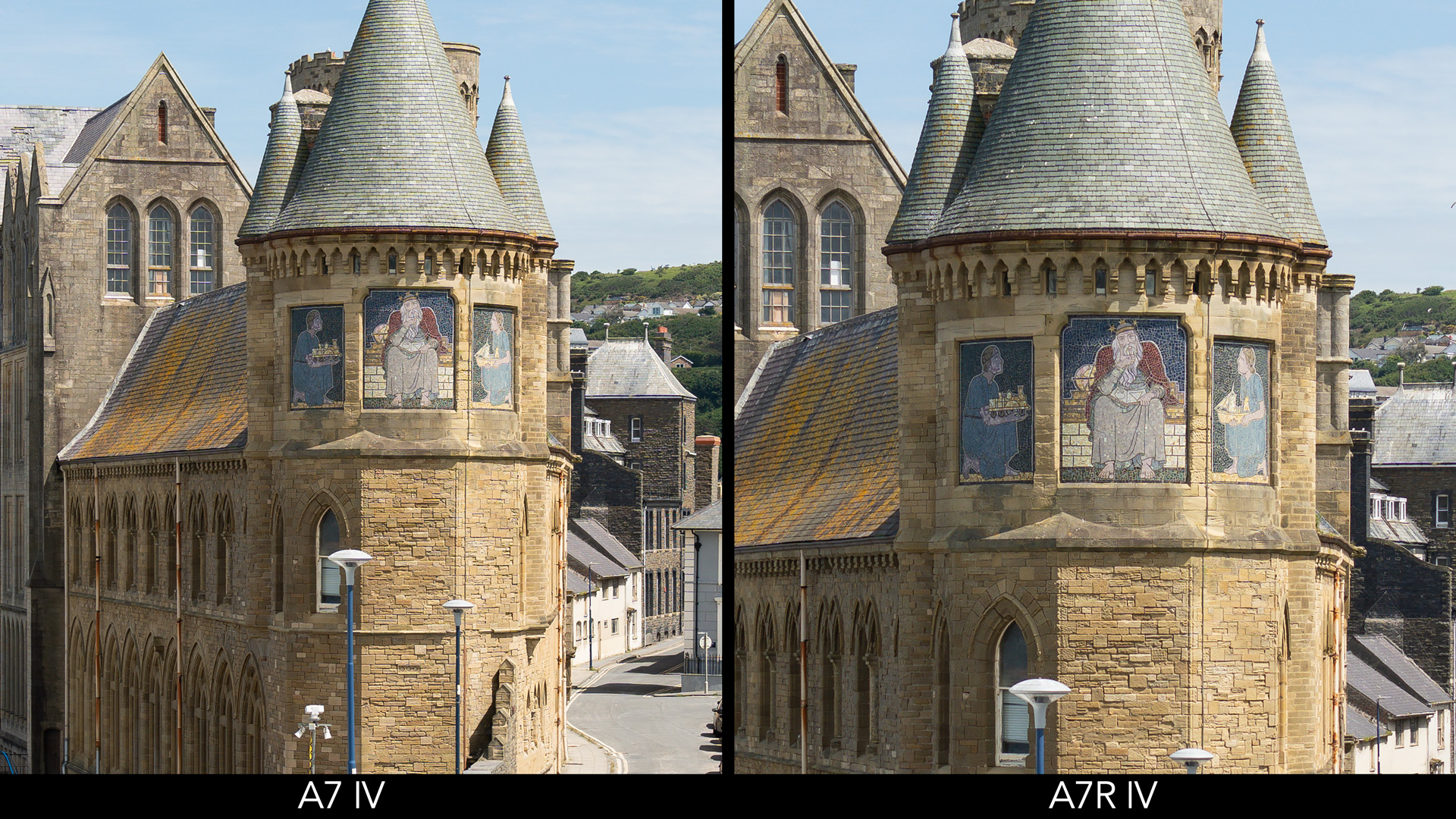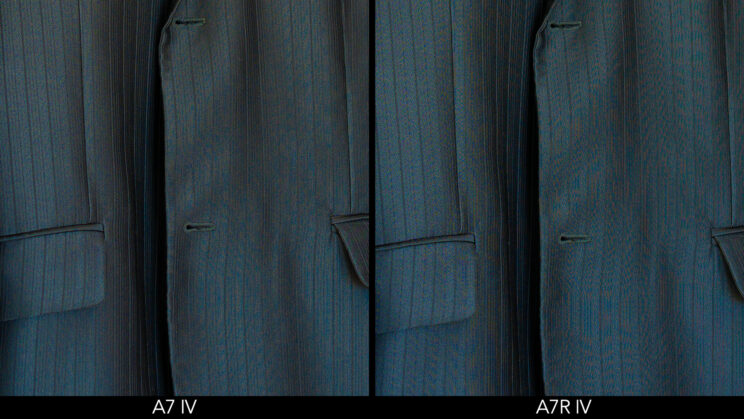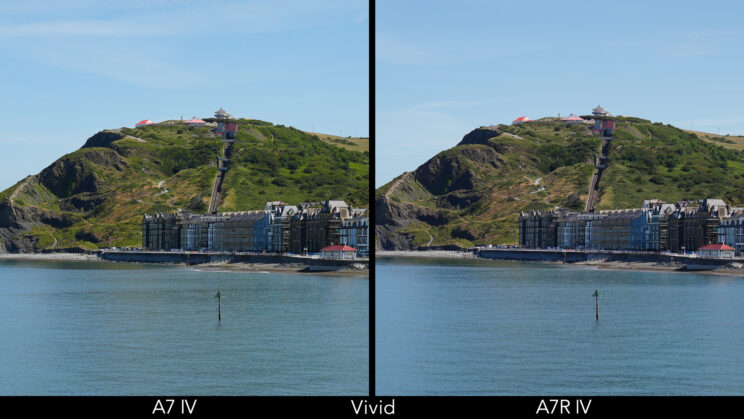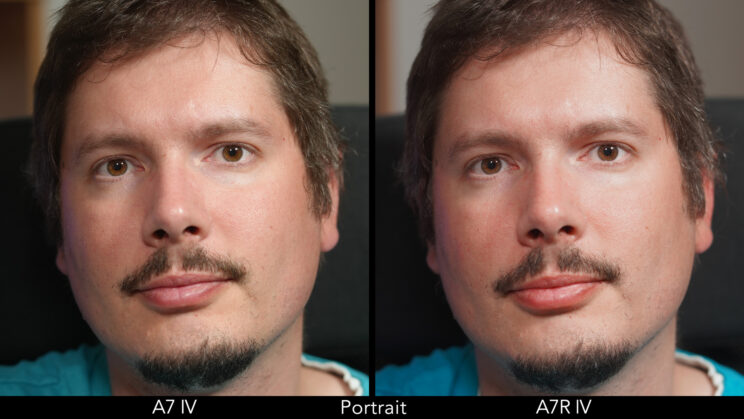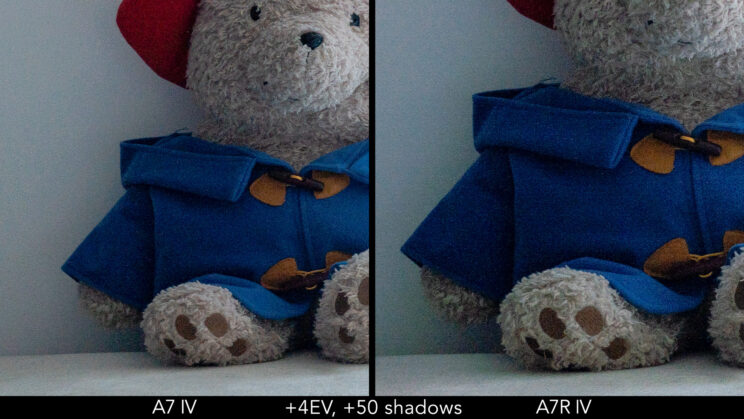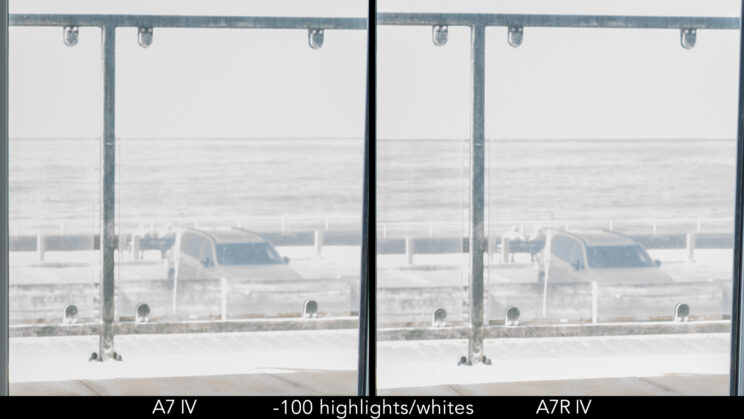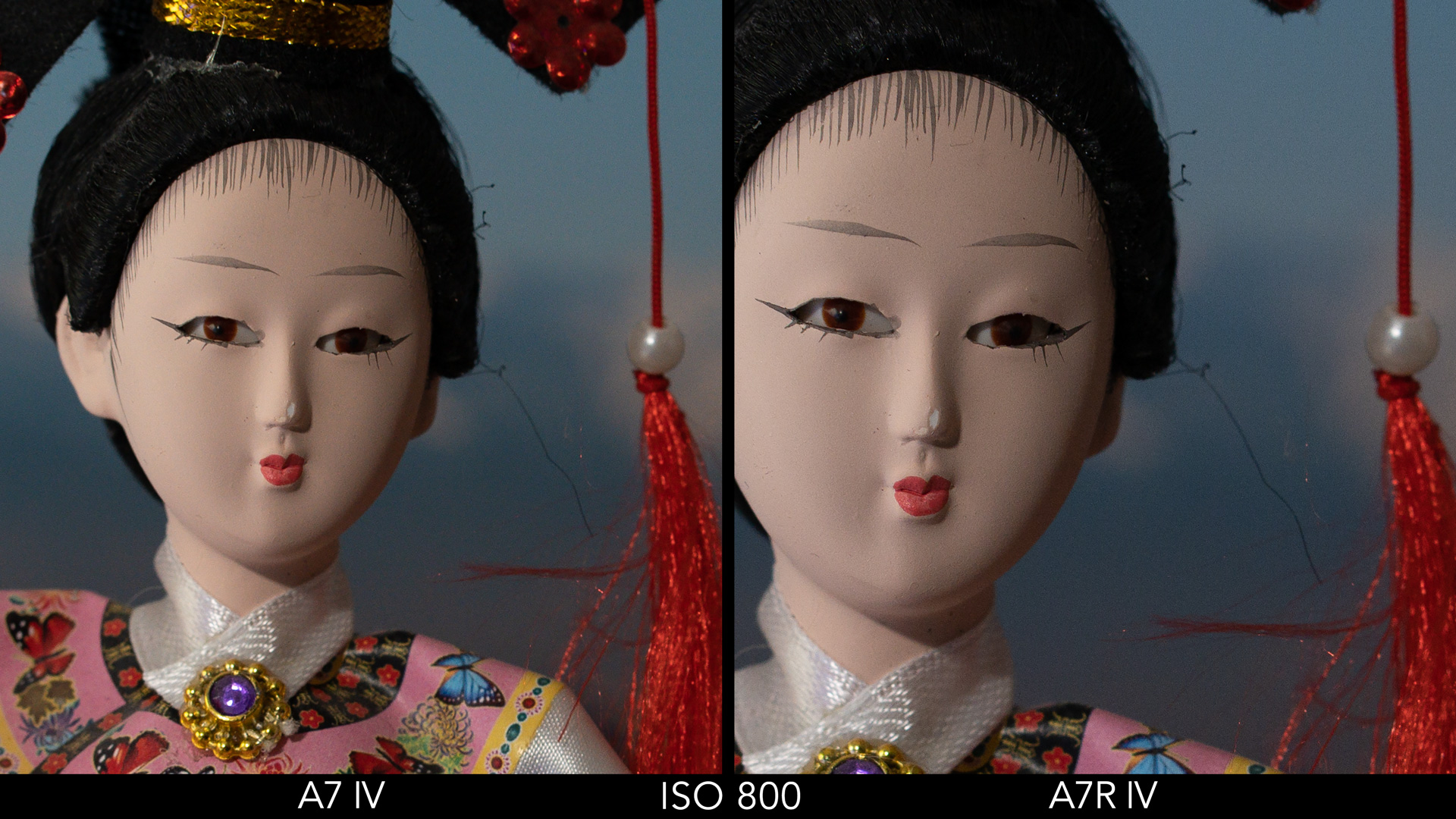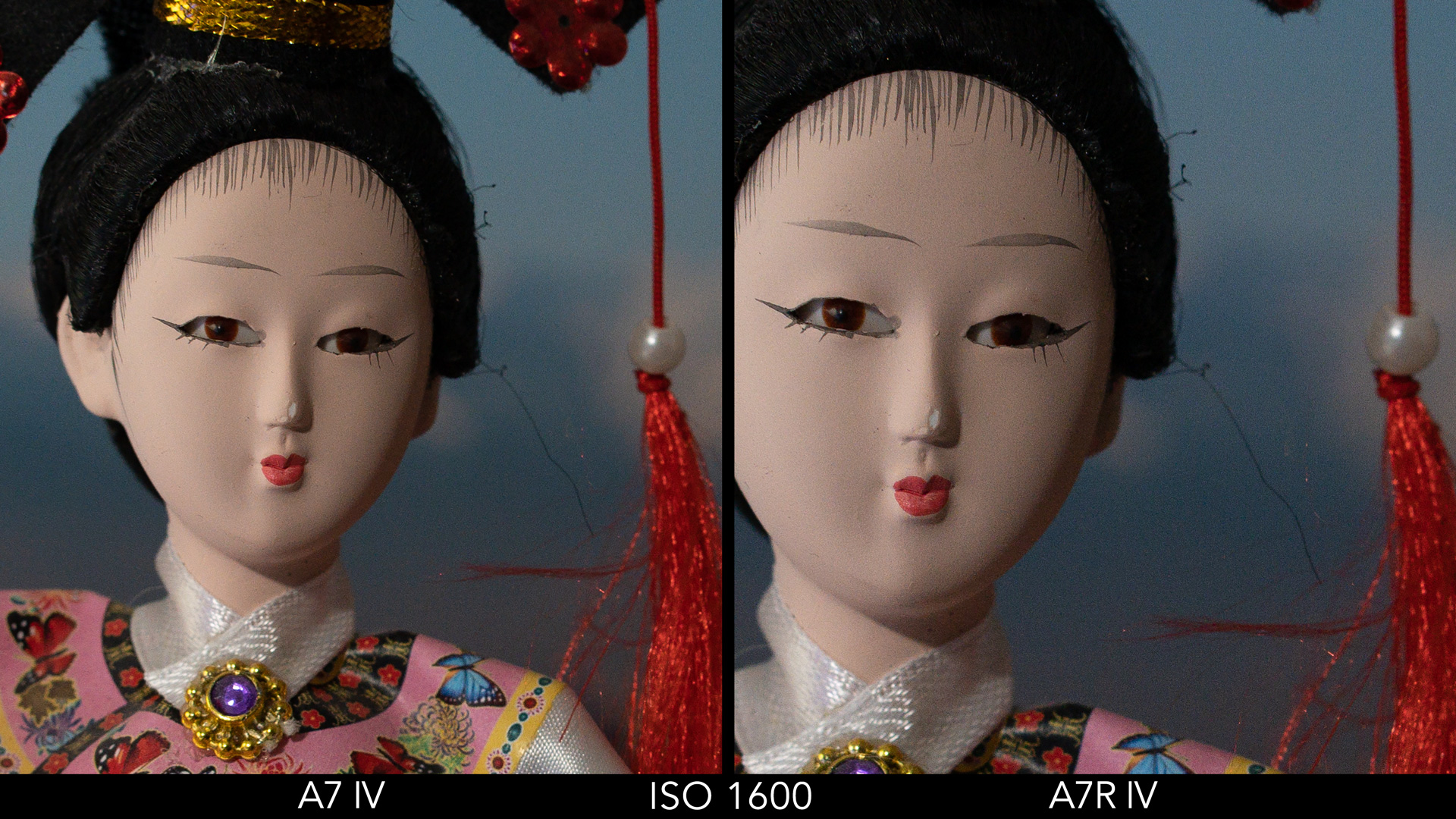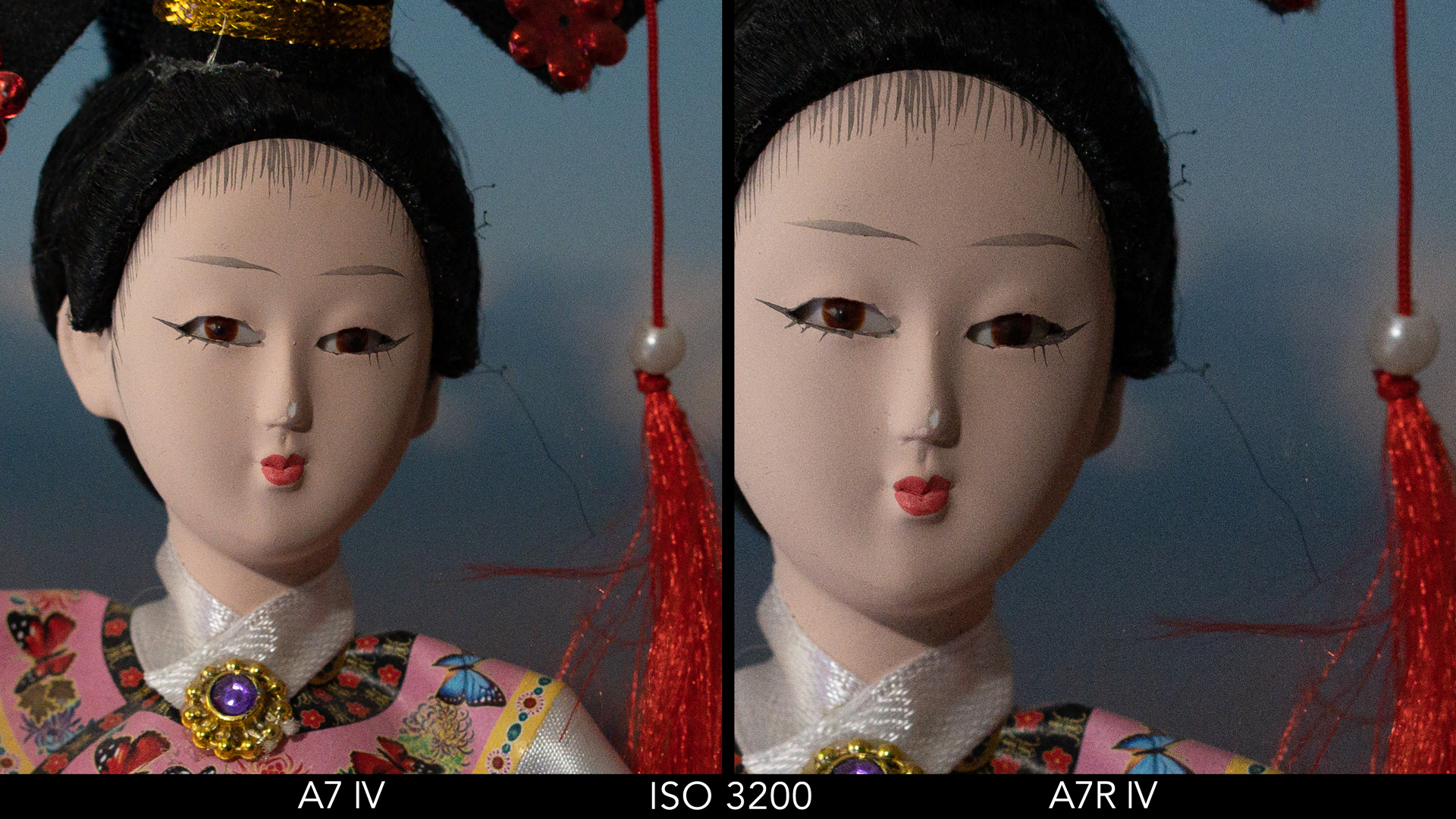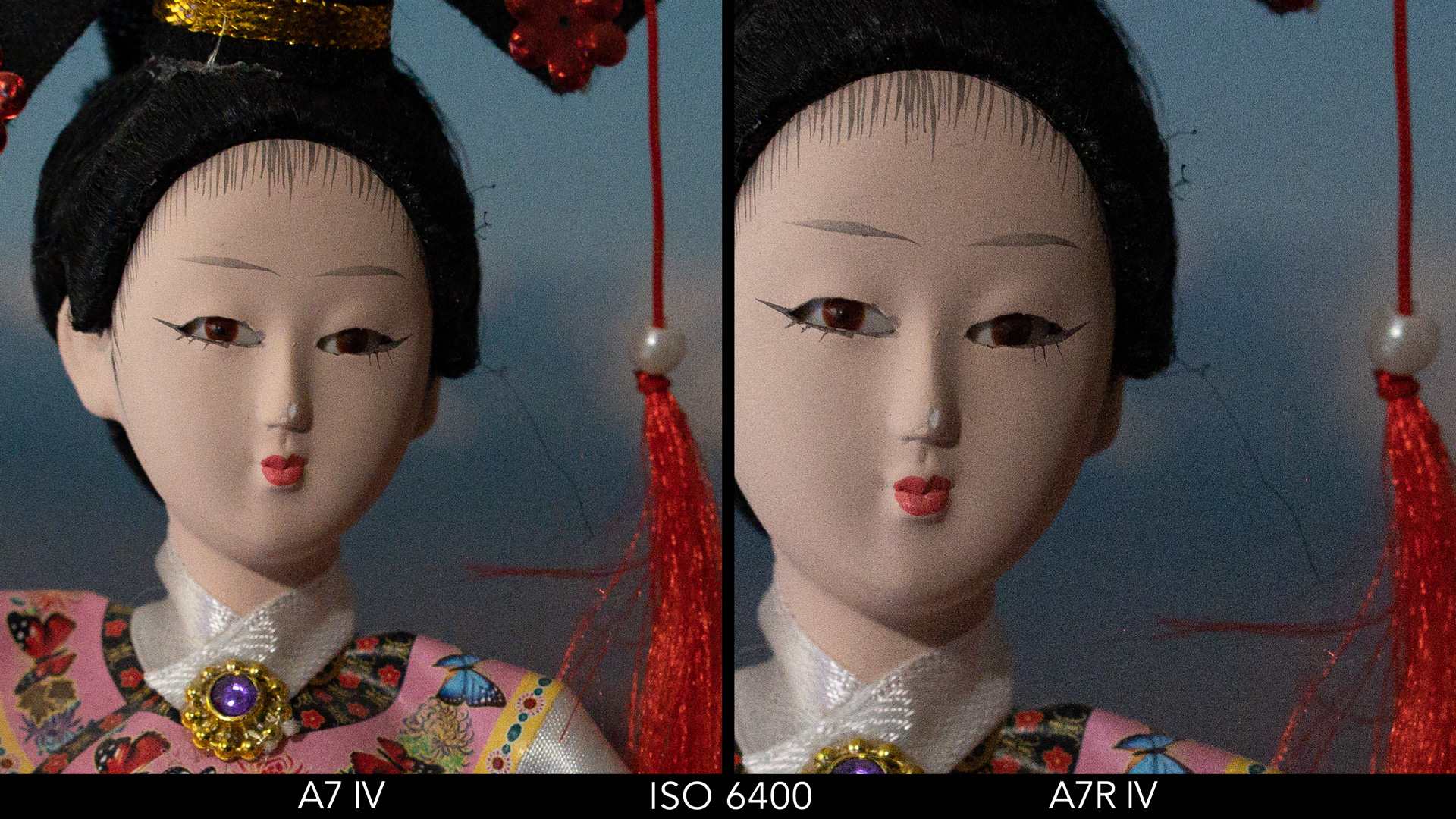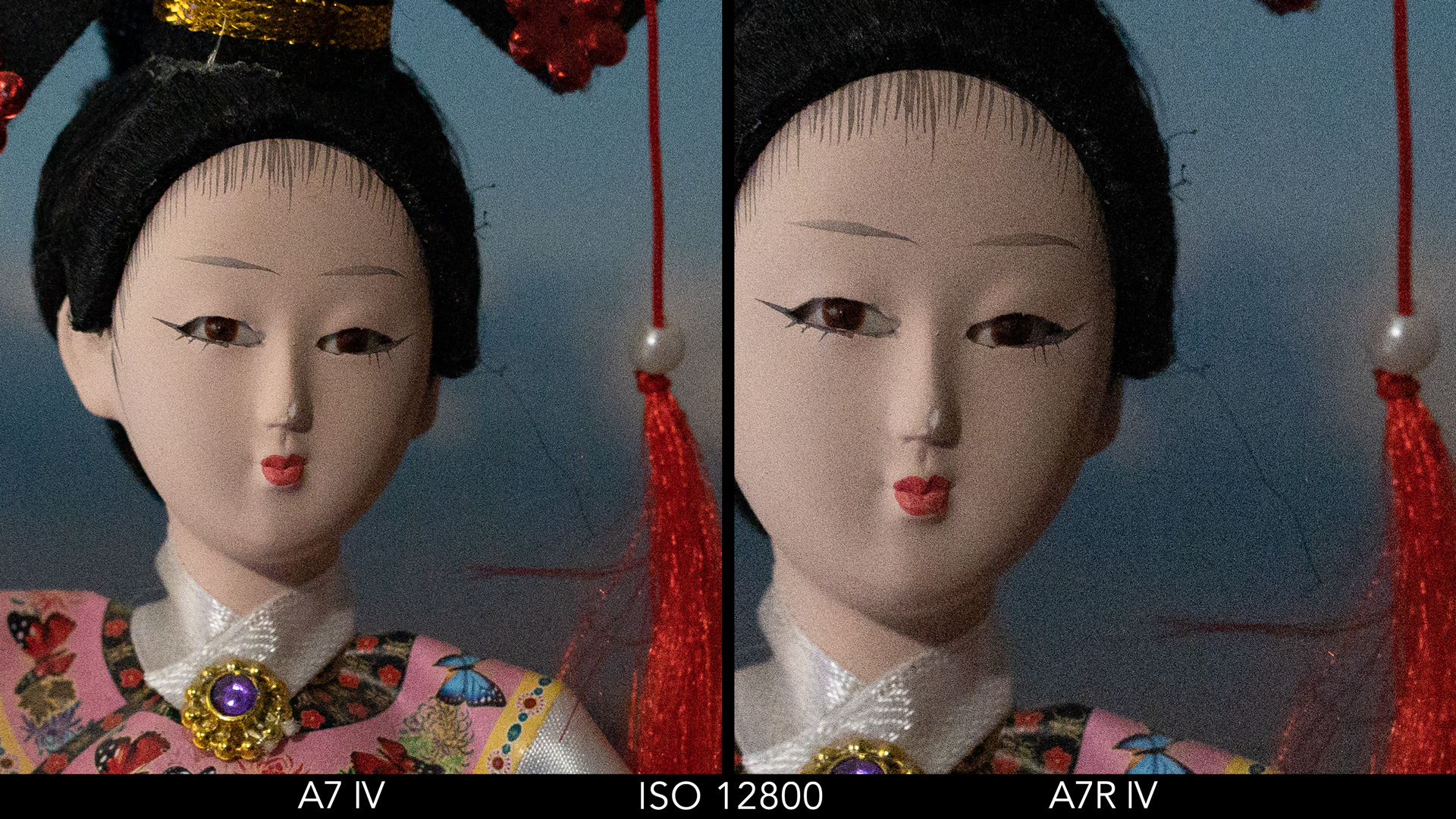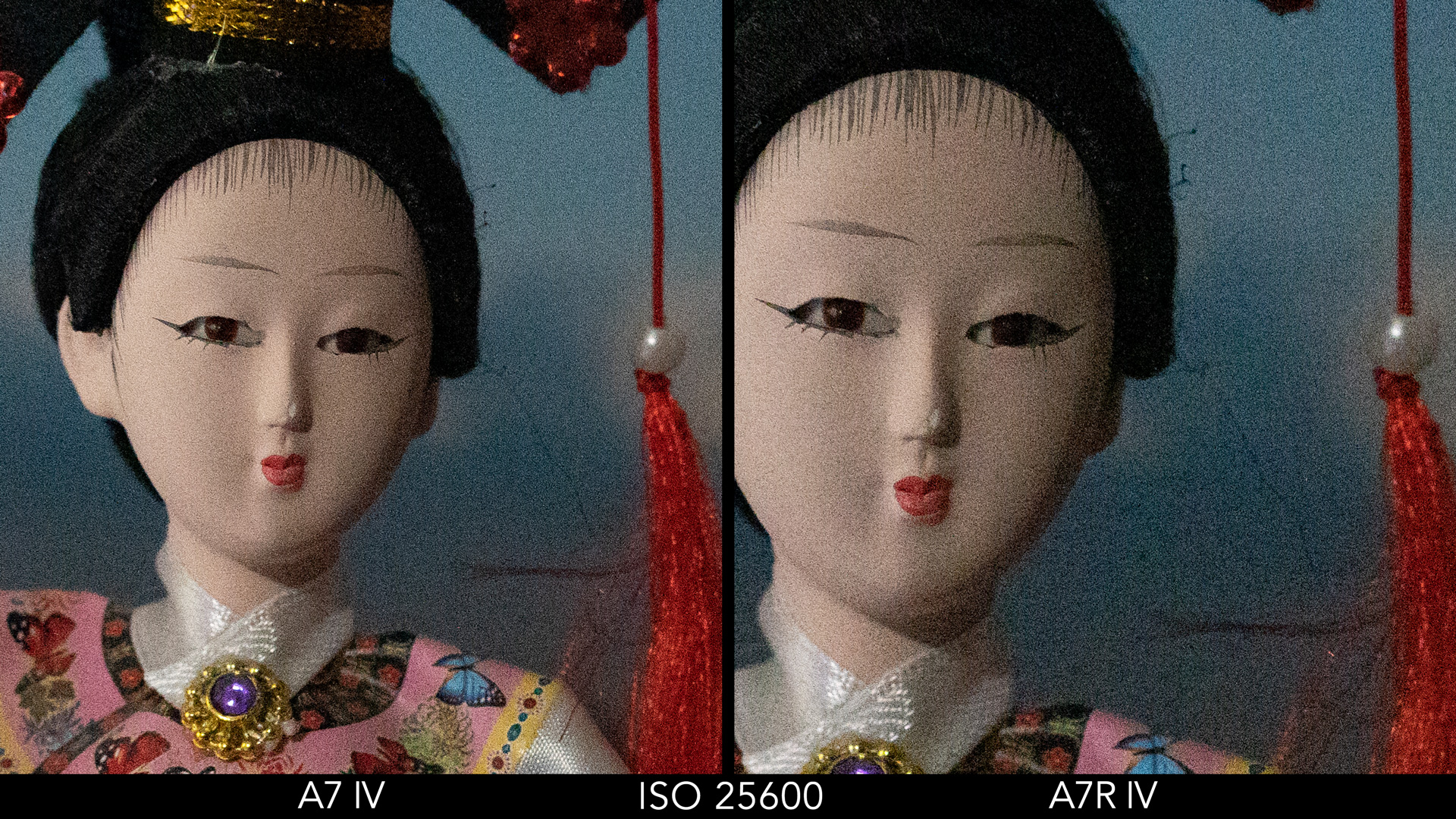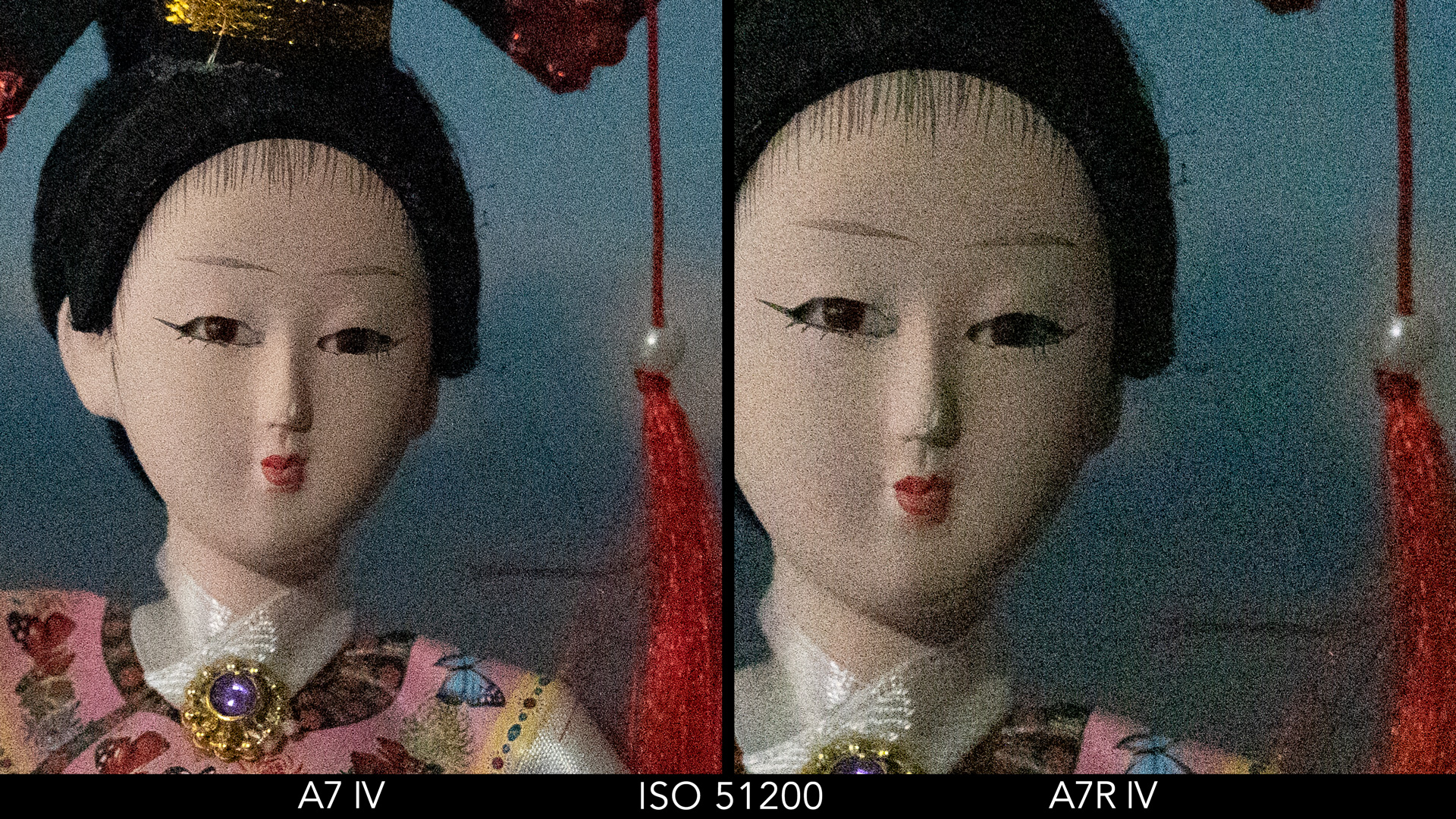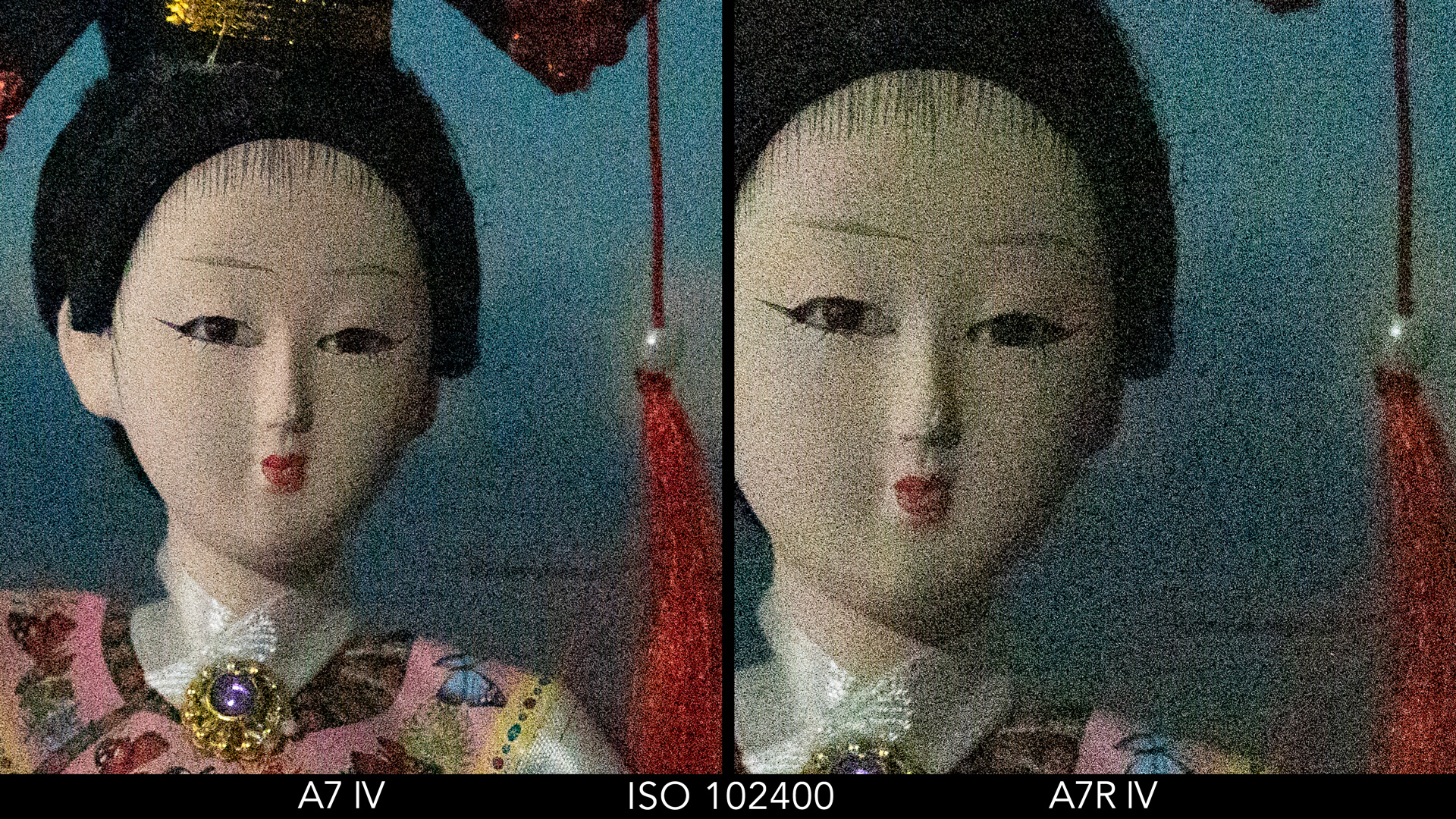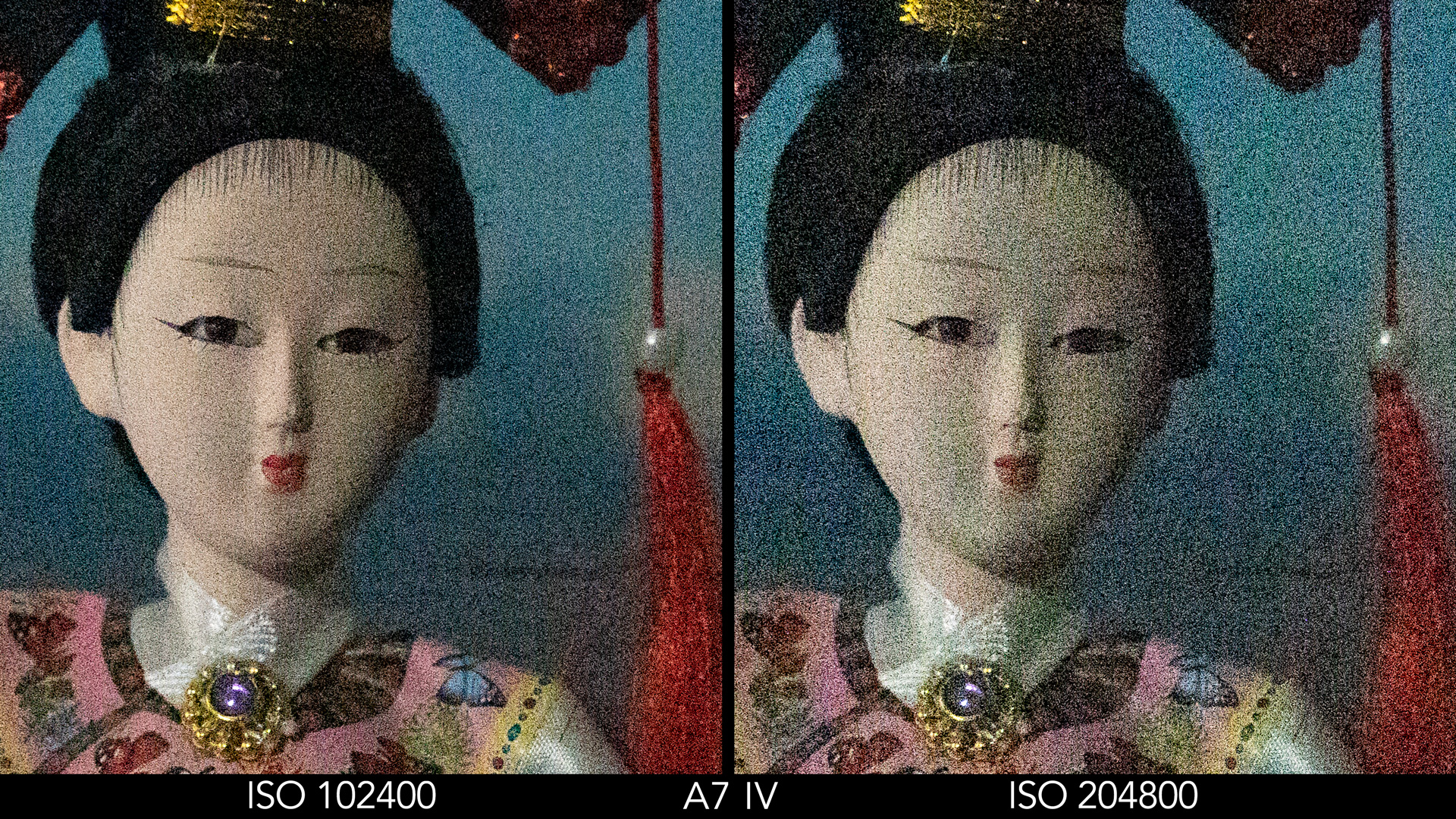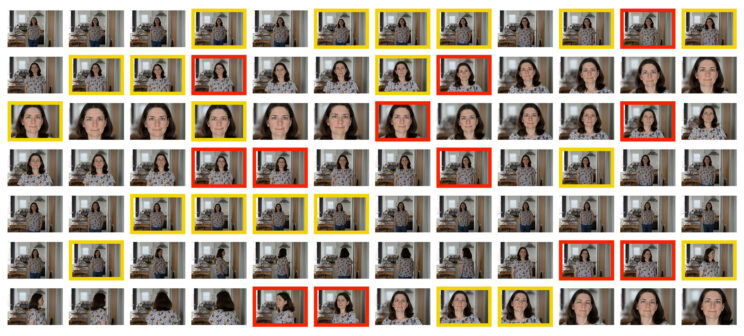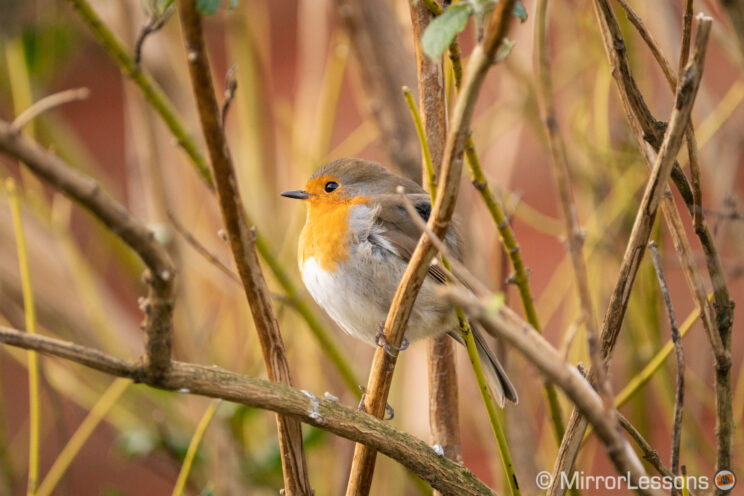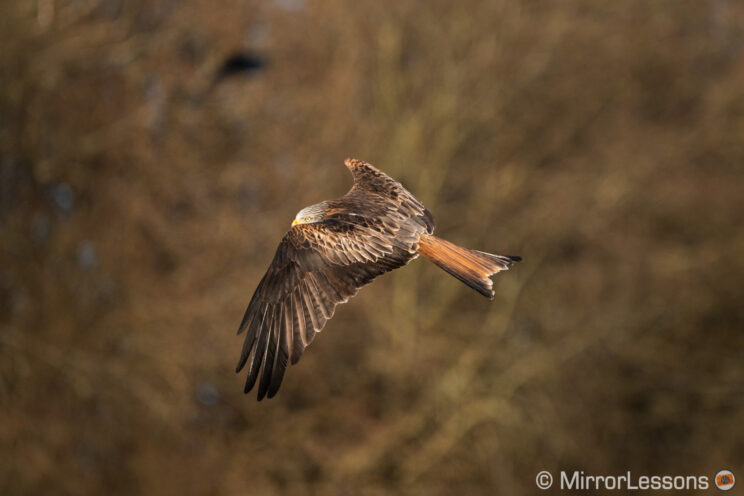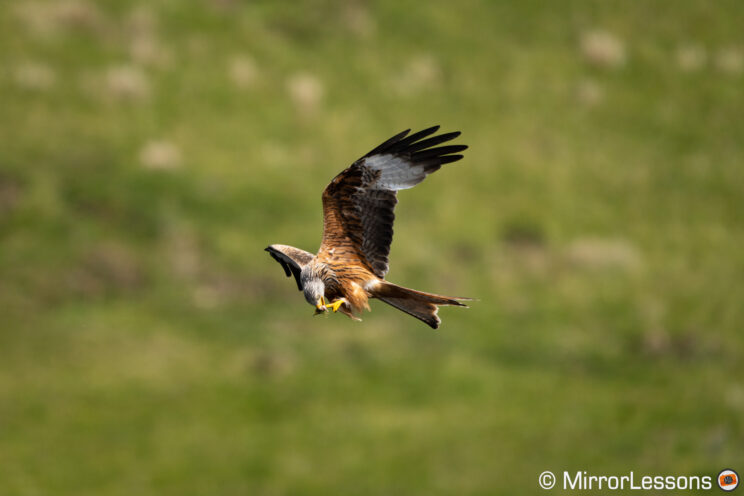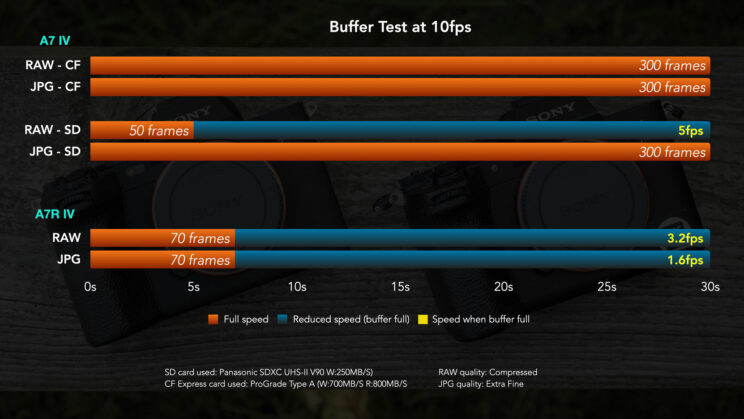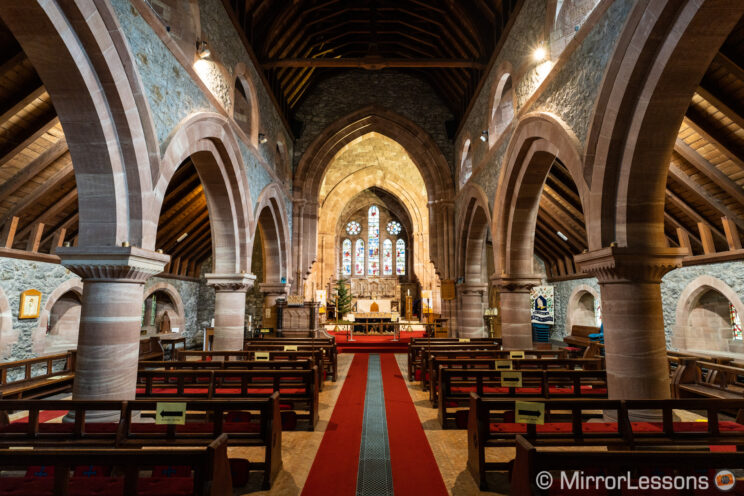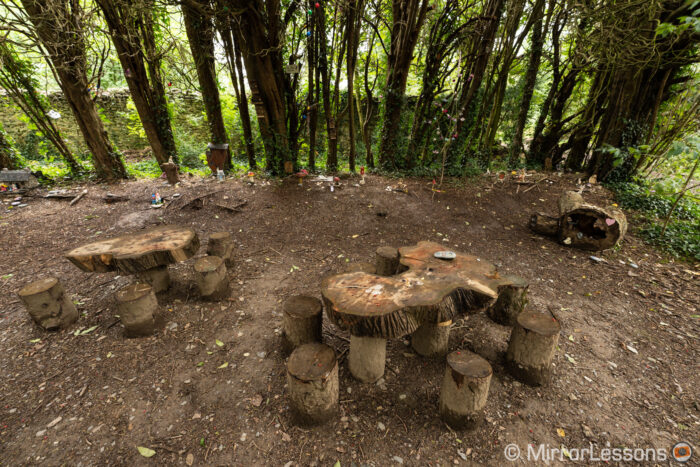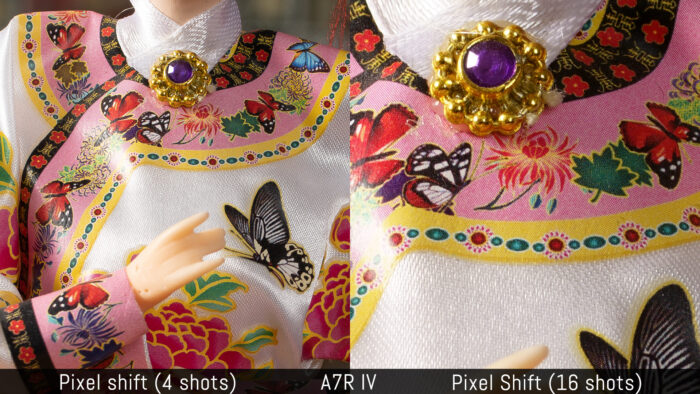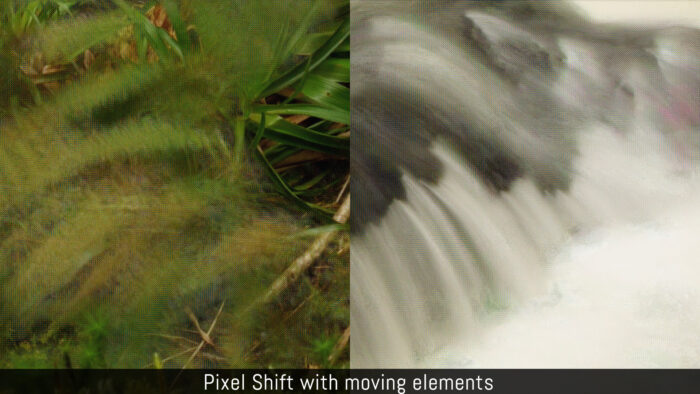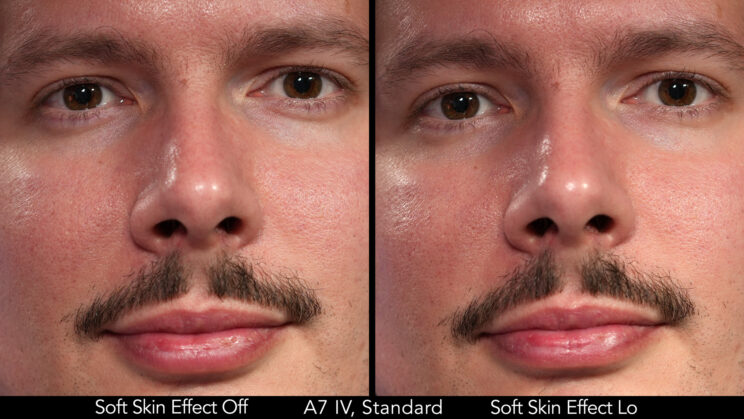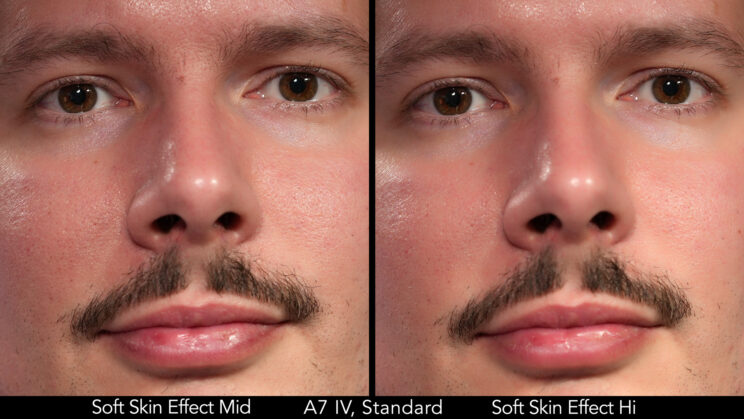The A7 mark IV is the successor to the very popular A7 mark III, and brings a lot of relevant improvements, from a new sensor to the updated AF system and video capabilities.
The A7R mark IV was released two years earlier and is the first full frame camera to feature 61 megapixels on the sensor.
On the outside, they look pretty much identical, but on the inside, there are a lot of differences to talk about.
Editor’s note: this article has been updated and now contains our completed feedback and tests with side-by-side images.
A7R IV vs A7R IVA
The original A7R IV has been discontinued and quietly replaced by the A7R IVA. The changes are very subtle, with the most noticeable difference being the higher resolution of the LCD screen (2.36M vs 1.44M dots on the original model). Other details are included in the chapters below.
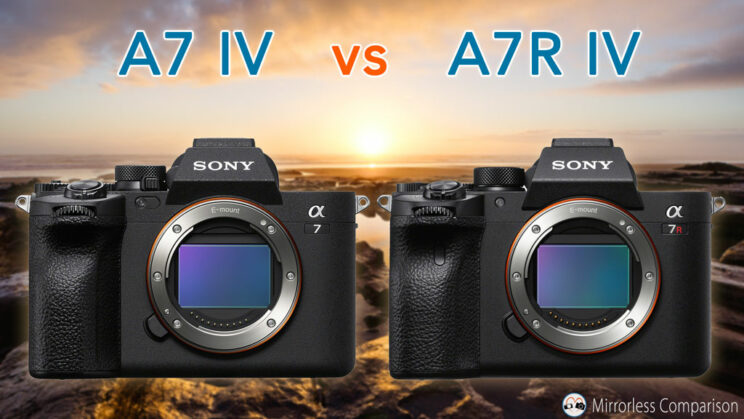
Ethics statement: the following is based on our personal experience with the A7 IV and A7R IV. We were not asked to write anything about these products, nor were we provided with any sort of compensation. Within the article, there are affiliate links. If you buy something after clicking the link, we will receive a small commission. To know more about our ethics, you can visit our full disclosure page. Thank you!
TABLE OF CONTENTS
– The 10 Main Differences in a Nutshell
– Main Specs
1. Sensor Resolution and Image Quality
2. Autofocus System
3. Buffer Memory
4. Pixel Shift Multi Shooting
5. Movie Recording
6. Viewfinder and Monitor
7. Design and Functionality
8. Memory Cards
9. Tidbits
10. Price
– Video Review
– Conclusion
The 10 Main Differences in a Nutshell
- Image Quality: the A7R IV produces impressive results concerning sharpness and details, in addition to giving you greater crop possibilities. It also performs very well up to ISO 12800. The A7 IV has updated picture profiles, and lots to offer when it comes to dynamic range.
- Autofocus: the A7 IV is more precise with face and eye detection, and also delivers a better keeper rate for birds in flight. The A7R IV is not too far behind concerning the latter, but struggles more with Eye AF.
- Buffer: the A7 IV has superior capabilities by a long margin when using the CF express card, which is however more expensive than a SD card. Both cameras go as fast as 10fps, which is quite the effort for the R model considering it has almost double the megapixels.
- Pixel Shift Multi Shooting: the performance concerning in-body stabilisation is pretty similar, but the R model uses the technology for an extra feature that produces a 240MP file!
- Movie Recording: the A7 IV has more features and advanced options, including 10-bit 4:2:2 internal recording and 4K 60p (in Super35 mode). The R model produces the best results in crop mode and has slightly more dynamic range in the highlights.
- Viewfinder and LCD monitor: the ‘R’ has more resolution for both. The A7 IV has more touch functionalities thanks to the new menu system.
- Design and Functionality: the A7 IV makes it easier to separate the still and photo modes, while also giving you more customisation options for each (including the memory recall that works in movie mode). The newest camera also sports a full sized HDMI port and a faster USB C port.
- Memory cards: both can work with two SD UHS-II cards, but only the A7 IV takes one CFexpress Type A card, which helps the buffer among other things.
- Tidbits: the A7 IV offers extra functionalities, including the possibility of USB streaming without any plugin or software required.
- Price: the A7R IV(A) is $1000 more expensive.
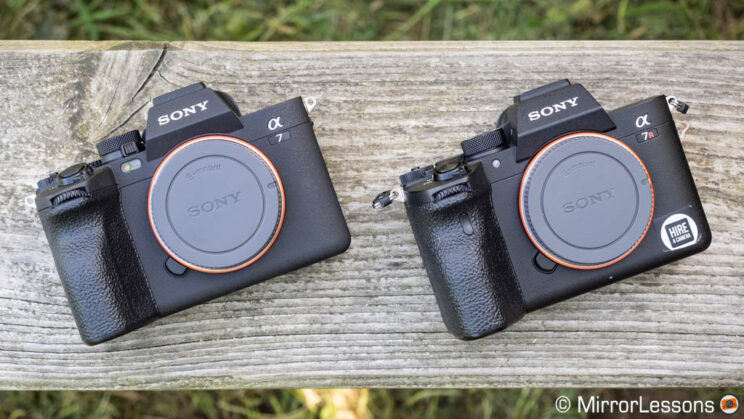
Main Specs
A7 IV
- Sensor: 33MP 35mm format BSI Exmor R CMOS
- Lens system: E-mount
- Weatherproof: Yes
- Internal Stabilisation: Yes (5-axis)
- Autofocus: Hybrid with 759 phase and 425 contrast detection points
- Continuous shooting: 3fps to 10fps with AE/AF Tracking
- ISO Sensitivity: 100 – 51200 ISO (pull 50, push up to 204800)
- Shutter Speeds: 1/8000 to 30s, Bulb
- Viewfinder: 0.5in OLED with 3.69M dots, 23mm eye point, 0.78x magnification and 120fps refresh rate
- Rear monitor: Multi-angle 3″ LCD (1.04M dots) with touch sensitivity
- Movie recording: 4K up to 60fps, Full HD up to 120fps, 10-bit 4:2:2 internal, S-Log, Cinetone and HLG gamma
- Built-in Flash: No
- Extra Features: WiFi, Bluetooth, Bracketing, Intervalometer, Wifi Tethering, USB streaming, Dual SD slots
- Dimensions: 131.3 x 96.4 x 79.8 mm
- Weight: 658g (including battery and memory card)
- Firmware version: 1.01
- Release: 2021
A7R IV / A7R IVA
- Sensor: 61MP 35mm format BSI Exmor R CMOS
- Lens system: E-mount
- Weatherproof: Yes
- Internal Stabilisation: Yes (5-axis)
- Autofocus: Hybrid with 567 phase and 425 contrast detection points
- Continuous shooting: 3fps to 10fps with AE/AF Tracking
- ISO Sensitivity: 100 – 32000 ISO (pull 50, push up to 102400)
- Shutter Speeds: 1/8000 to 30s, Bulb
- Viewfinder: 0.5in OLED with 5.76M dots, 23mm eye point, 0.78x magnification and 120fps refresh rate
- Rear monitor: Multi-angle 3″ LCD with touch sensitivity (1.44M dots on A7R IV, 2.36M dots on the A7R IVA)
- Movie recording: 4K up to 30fps, Full HD up to 120fps, S-Log and HLG gamma
- Built-in Flash: No
- Extra Features: WiFi, Bluetooth, Bracketing, Intervalometer, Wifi Tethering, Dual SD slots
- Dimensions: 128.9 x 96.4 x 77.5 mm
- Weight: 665g (including battery and memory card)
- Firmware version: 1.20
- Release: 2019 (2021 for the ‘A’ version)
1. Sensor Resolution and Image Quality
Both cameras feature a full frame sensor with BSI (back-illumination) but the main difference is the number of pixels: the A7 IV has 33MP, whereas the R model has almost double that at 61MP.
In the first side by side image below, you can appreciate the larger details rendered by the A7R IV.

The R model lacks a low pass filter in order to maximise sharpness. There hasn’t been any official confirmation regarding the presence of a low pass filter on the A7 IV, and there are contrasting opinions on the Internet regarding whether it has one or not. In my view, if there is one, it’s a weak version. I did an extra test to find traces of moiré: as you can see below, the A7R IV shows more of it, but the A7 IV is not immune either.
The A7 IV also features a more recent image processor, the BionZ XR, which has faster processing capabilities than the BionZ X on the R model. Additionally, the new camera comes with the latest updates concerning the colour palette and the picture profiles. In fact, the A7 IV has a new set called Creative Looks, which replaces the old Creative Style found on the ‘R’.
The difference are not always striking, but in the example below you can see how the A7 IV produces more vibrant greens on the hill, and the blue of the sky/water has slightly less magenta.
The difference is a bit more visible with skin tones, where the A7R IV shows more of a red dominance in comparison to the more recent camera model.
Moving on to the dynamic range test, both cameras do equally well. They retain the same amount of highlights, and shadow recovery is on par too. If we really want to nitpick, I could mention that the A7R IV produces a bit more colour cast around the paws of the stuffed toy, but it’s a small difference.
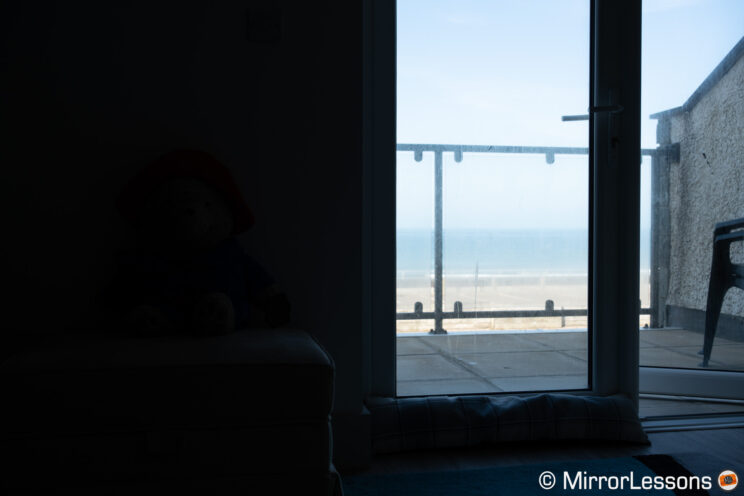
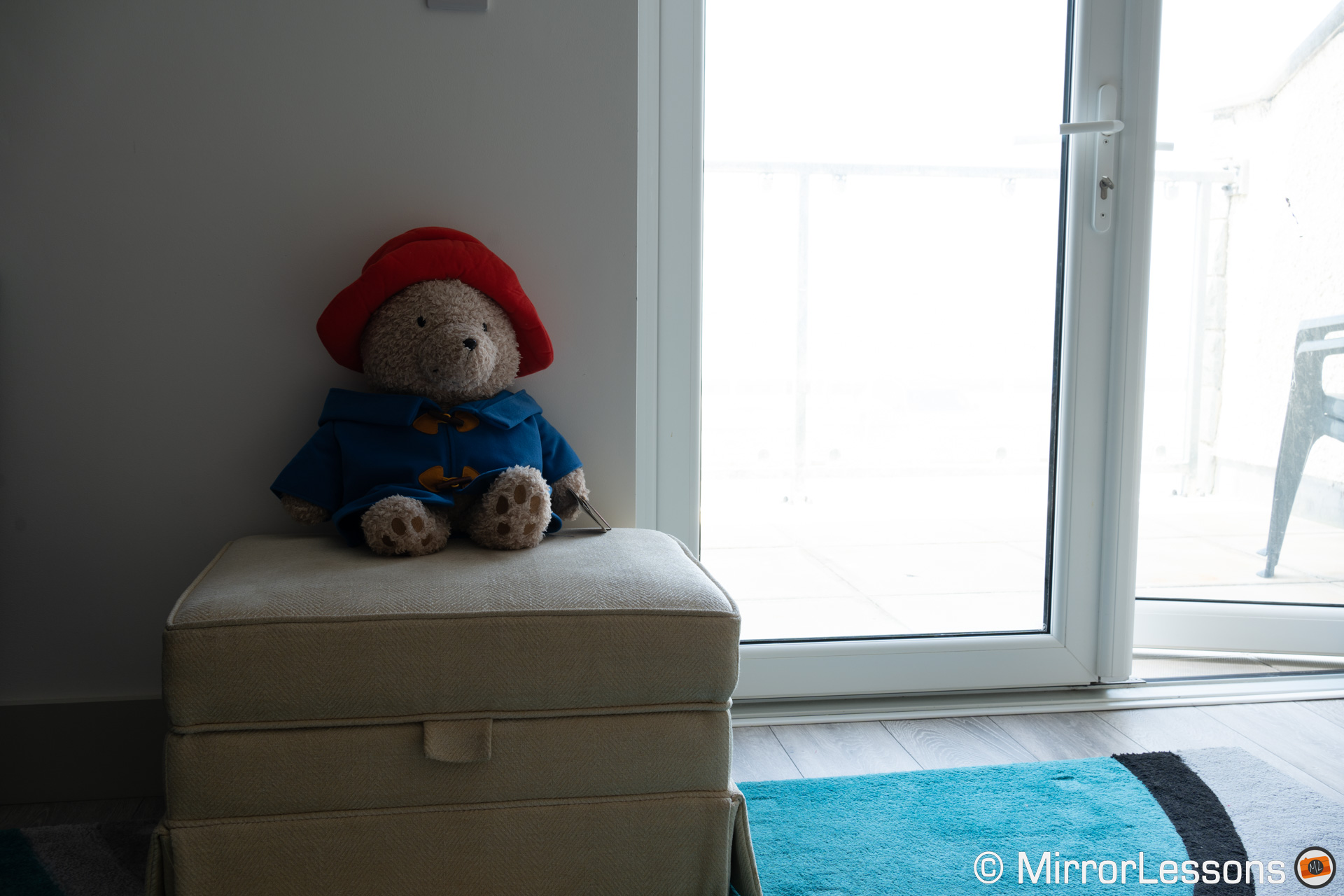
Then we have the ISO range, which is wider on the A7 IV:
ISO
Normal range
Extended range
A7 IV
100 – 51,200
50 – 204,800
A7R IV
100 – 32,000
50 – 102,400
I was pleased to see how well the A7R IV can handle high ISOs, despite the higher megapixel count. Up to 12,800, the results are comparable. It’s only from 25,600 that you start to see more noise on the ‘R’, and the difference becomes greater from 51,200 because it starts using the extended values sooner than the A7 IV. Needless to say, the highest ISO levels look pretty bad on both.
One last thing worth highlighting is the possibility of selecting Lossless compressed RAW on the A7 IV, whereas the A7R has Lossy compressed and Uncompressed only. And if you’re wondering how much space a RAW file takes on a memory card for each camera, have a look at the table below.
RAW Quality
A7 IV
A7R IV
Uncompressed
68MB
120MB
Lossless Compressed
38MB
–
Compressed
35MB
62MB
2. Autofocus System
Both cameras feature Sony’s hybrid focus technology and advanced algorithm that includes real-time tracking and Eye AF.
The A7 IV has more phase detection points – 759 to be exact – and they cover 94% of the sensor area.
The A7R IV has 567 phase points and they cover 99% of the sensor’s height, and 74% of the sensor’s width.
The number of contrast detection points is the same for both cameras: 425.
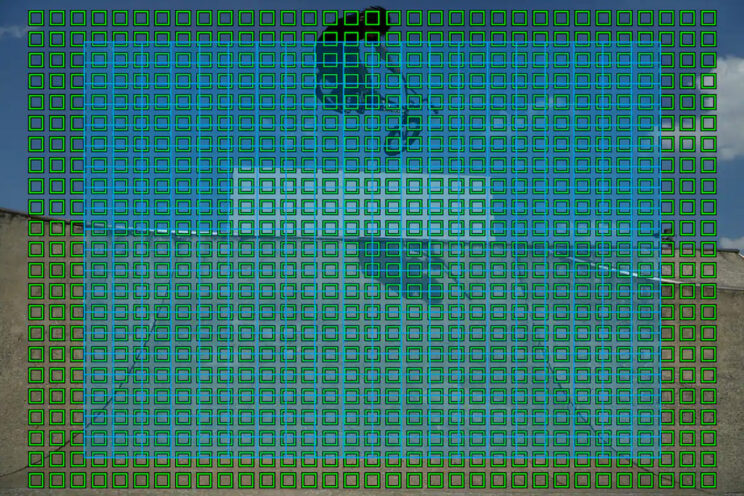
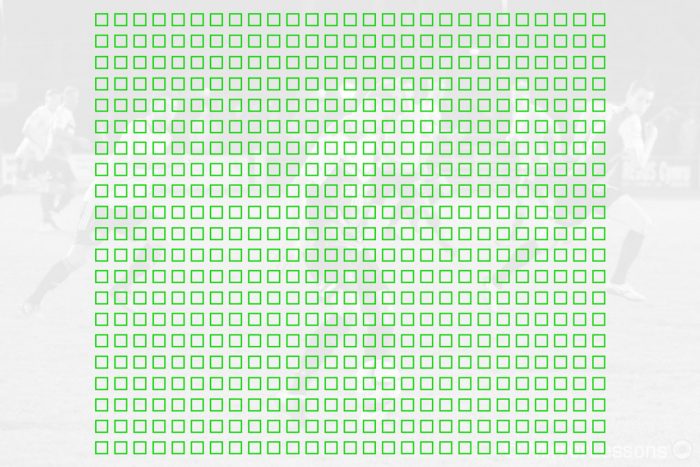
The A7 IV has a one stop advantage in low light, with a rating of -4Ev, versus -3Ev on the A7R IV (both measured with an F2 lens).
Another improvement is phase detection autofocus which works up to f/22 on the A7 IV, at a 6fps or faster drive speed. The A7R IV can’t manage smaller apertures than f/11. This means that the A7 IV can work with full AF performance when using a lens like the FE 200-600mm and the TC 2.0x (f/13 at 600mm).
Concerning the software, the A7 IV has the most recent processor, so it receives a few extra features. For example, Eye AF works with birds in addition to humans and animals, and the three subject types (humans, animals, birds) also work in video mode.
On the R model, bird detection is not available and Eye AF only works with humans during movie recording.
Real world feedback
In S-AF mode, I struggled to find relevant differences between the two cameras. As long as the amount of contrast is decent, they can both do a fine job.
In a severe low light test, the A7 IV did better than the R model. It managed to take 6 shots at the beginning of the sequence (although not all of them were in focus), then it stopped until the end of the walk when extra light coming from the TV helped the camera reacquire focus.

1/200s, f/2.8, ISO 51200 (FE 85mm F1.8)
The A7R IV couldn’t take more than two images at the beginning, and was only able to re-focus correctly at the end. Note that I used Focus rather than Release priority on both cameras, which is why they didn’t take any images in the middle of the sequence, as neither was capable of focusing correctly at that point.
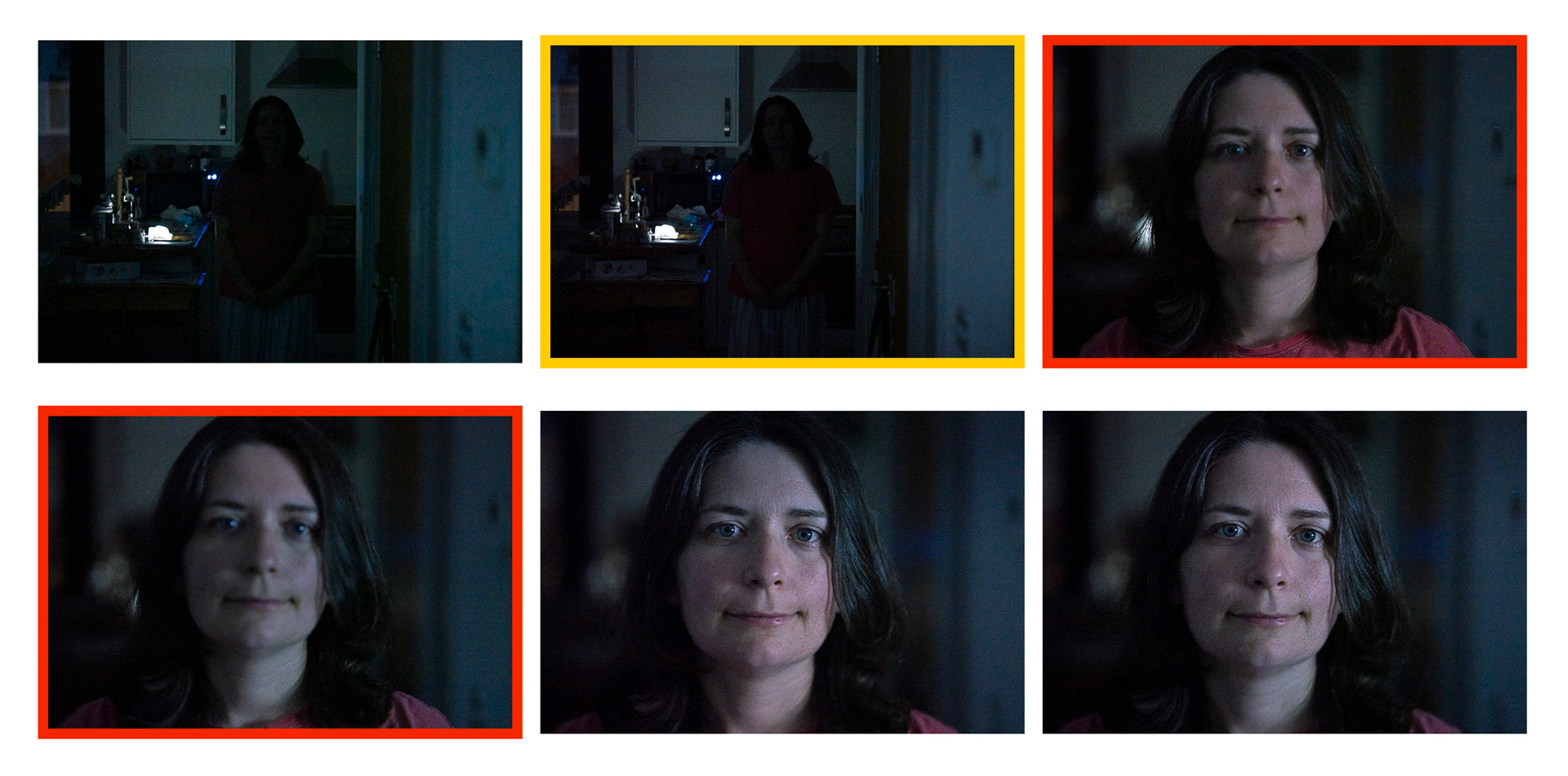
1/200s, f/2.8, ISO 51200 (FE 85mm F1.8)
With face and eye detection, the A7 IV has the edge. In the test below, where the subject walked back and forth, and then walked while turning on herself, the camera gave me a very good hit rate of 88%, which beats the score of 80% in my first review of the camera (probably thanks to firmware 1.01 that improves the Eye AF performance).
The A7R IV has a lower score, not so much because of out of focus images, but because of the bigger presence of slightly soft results, where the eyes are a bit soft in comparison to the nose or ears of the subject (meaning focus is a little too short or far). It also struggled more when the subject was further away at the beginning of the sequence, as well as when she turned 360˚ near the end.
With both cameras, I advise you to use the tracking mode with a small area (I select Expand Flexible Spot). Once the subject is tracked, the camera priortises the face or eyes when detected, but can also stick to the subject when the face is momentarily covered. It is the setting I use to take pictures of my toddler and I find it more reliable than other AF modes.
When taking portraits, the two E-mount products allow you to priortise the left or right eye, and this option can be assigned to a custom button.
Eye AF also works for animals, but the ‘R’ model can’t detect birds. That gives the A7 IV a distinctive advantage, especially with small birds perched on a tree because A) you don’t have to move a small AF point manually (the eye is tracked across the entire frame), and B) you have a higher chance of ensuring the eye of the animal is in focus, rather than its body, when working at a close distance.
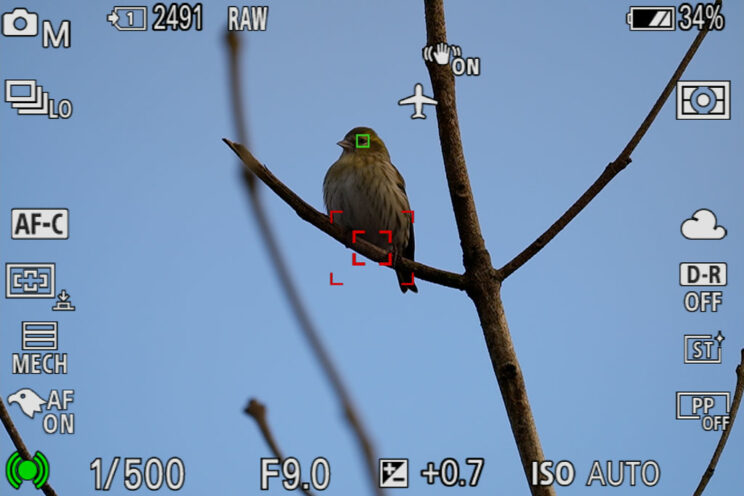
On the A7R IV, composing can take more time as you try to place the small focus point on the head of the bird.
Eye AF for birds is very precise, and it can detect the animal even when it is partially covered by branches or other things, although the accuracy of the result can vary depending on how much the subject is covered. It’s not perfect and may not recognise all the species, but it’s of great help when it does. Note that the eye won’t be detected if the bird is too far away.
Moving on to my birds in flight test, the A7 IV gave me an excellent result, close to that of the A9 II. The latter has a faster drive speed obviously, but it shows it’s an AF system you can trust even for difficult subjects.
The A7R IV is not far behind. It struggles a bit more when the subject is at a distance (smaller in the frame), where the number of slightly soft results increase.
The Tracking AF mode, coupled with the Expand Flexible Spot, proved to be the best setting to use on both cameras and gave me the best keeper rate.
A7 IV
94%
99%
A7R IV
88%
100%
Note: to know more about about my birds in flight test, check the dedicated article.
In video mode, I found both cameras gave similar results. The A7 IV is a bit faster at tracking a human subject with Eye AF, in good and low light conditions.
It also has more precise controls when it comes to the autofocus speed and sensitivity. The AF Transition Speed and AF Subject Shift Sensitivity work with more steps of adjustment than the settings found on the R model (AF Drive Speed and AF Track Sens).
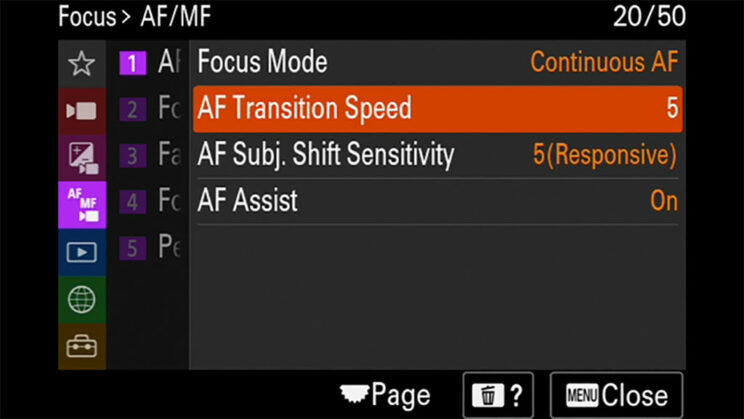
Finally, the A7 IV has the AF assist option, which allows you to make manual focus adjustments while autofocus and tracking are enabled.
3. Buffer Memory
The two cameras share the same continuous shooting speed of 10fps maximum (with AF/AE tracking). The A7R IV looks especially good here considering the higher megapixel number.
There are a few things to keep in mind though. The A7 IV can achieve the claimed 10fps only with JPG, or Lossy compressed RAW. If you select Lossless compressed or Uncompressed RAW, the speed drops to about 6fps.
The A7R IV can work at the claimed fastest speed of 10fps when shooting in JPG or Compressed RAW. With Uncompressed RAW, the maximum speed floats around 7.5fps.
As you can imagine, the buffer capabilities are quite different.
The R model can work at 10fps for about seven seconds, giving you 70 frames before slowing down dramatically. Interestingly, the buffer is slower to recover when shooting in JPG, and the speed also drops more than when working with compressed RAW.
The A7 IV doesn’t slow down in the first 30s of the burst when using the CFexpress Type A card. The same result applies with JPG if you use a SD UHS-II card, but with RAW (compressed), the buffer fills after 5 seconds, and the speed drops by half afterwards.
4. Pixel Shift Multi Shooting
Both cameras feature 5-axis image stabilisation with a CIPA rating of 5.5 stops of compensation.
The performance, as expected, is similar: photos taken hand-held at around half a second, or a quarter of a second (between 24mm and 55mm) are not impossible, but the keeper rate is low. You need to work around 1/10s or faster to have a decent performance over multiple shots.
Like many other Sony full frame cameras, it remains a system that can’t be fully trusted: I can struggle to obtain a sharp shot at around 1/20s or even 1/40s on occasion. Always check your photos after the capture.
The results can vary a little depending on the lens used. For example, a standard zoom lens with optical stabilisation, such as the FE 24-105mm F4, can push the performance a bit further, but what I said in the paragraph above remains valid regardless.
The A7R IV has an extra features that works with the IBIS mechanism, and it is called Pixel Shift Multi Shooting.
When taking a picture with this mode activated, the camera captures 16 photos and moves the sensor by half a pixel (8 times) and one pixel (8 times) between each capture. The result is a whopping 240.8MP photo!
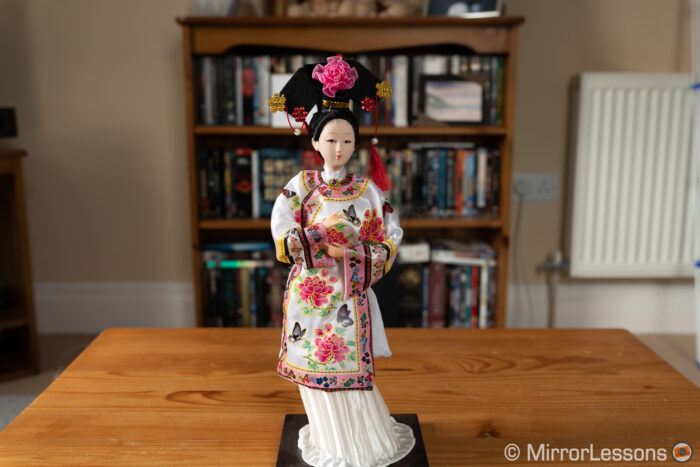
Note that the 16 images must be composited in post using the Sony Imaging Edge desktop software. Also, this mode requires the camera to be on a tripod and with no moving subjects for optimal results. Anything not stable in your frame can create artefacts, as you can see in the example below.
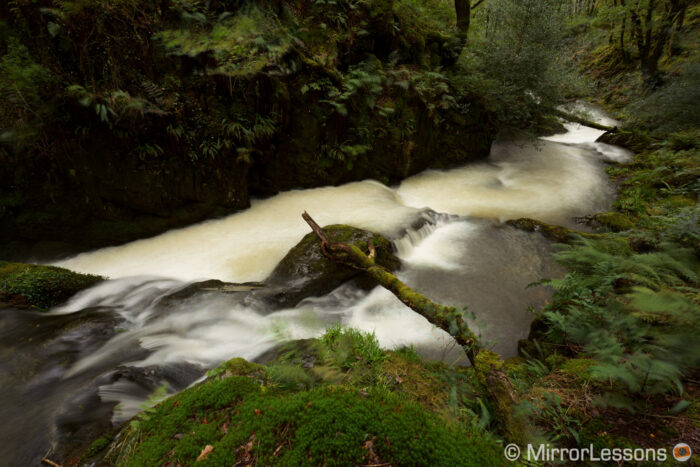
There is also another options where the camera only composites 4 images instead of 16. The resolution output doesn’t change (61MP) but the colour resolution increases because each point of your photo has been captured by at least one red, green and blue pixel.
5. Movie Recording
There are a lot of differences to talk about when it comes to video. In short, the A7 IV can do 4K 60p (in Super35 mode) and can record 10-bit 4:2:2 internally with a maximum bitrate of 600Mbps. The table below gives you an overview of everything you need to know.
A7 IV
A7R IV
4K 30p
no crop
no crop
4K 60p
1.5x crop
–
Full HD
120p
120p
10-bit
H.264 (4:2:2)
H.265 (4:2:0)
HDMI (4:2:2)
–
Profiles
S-Log2/3
HLG
Cinetone
S-Log2/3
HLG
Bitrate
200M (Long GOP)
600M (ALL-I)
100M (Long GOP)
Rec. Limit
No
No
ISO
100 – 102,400
100 – 32,000
One important thing to understand is that, because of the higher megapixel count, the A7R IV does line-skipping when recording video in full frame mode. The quality is far from awful, but the tradeoff is aliasing which can be visible when dealing with fine details. For better quality (full pixel readout), you need to use the Super35/APS-C mode.
On the A7 IV, the maximum quality can be achieved in full frame mode (up to 30p), where the camera over-samples from a region of 7K. It also works well in Super35 mode.
At high ISO in full frame mode, the A7R IV shows less noise surprisingly, but the details become softer as you increase the value. I guess the camera applies more noise reduction to avoid too much noise, which would be more severe by default considering the higher resolution of the sensor.
In Super 35 mode, the R model does better than the A7 IV, and without losing details, up to 12,800. At 25,600, noise remains lower but noise reduction becomes more aggressive.
The difference between the Creative Looks of the A7 IV and the Creative Styles of the R model that I highlighted in the first chapter of this article are valid for video too but it is less visible in comparison to photographs.
The best dynamic range is obtained with the HDR or Log profiles. With equal settings using the HLG3 gamma, the A7 IV produces slightly brighter shadows but loses some details in the highlights. The same difference is found when using the S-Log2 and S-Log3 profiles.
Bear in mind that with the Log curve, the minimum ISO available is 500 on the R model. On the A7 IV, it is 800 and you can select lower values (down to 200) but these are extended levels, so you lose dynamic range as a result.
The A7 IV has an extra setting, S-Cinetone, which gives you a cinematic palette. It lacks saturation with the factory parameters, but you can change that in camera or in post.
Rolling shutter is more or less the same in full frame mode: visible when moving slowly, severe when moving quickly. In crop mode, the A7R IV gets worse, especially when panning quickly, whereas the performance on the A7 IV is much better overall.
In my overheating test, the A7 IV was able to record non-stop for two hours without any problem, and without the overheating warning appearing on the screen. The A7R IV managed the same result (ambient temperature between 21˚C and 22˚C).
Finally, the A7 IV has extra settings and features you won’t find in the R model, such as:
- Active mode: makes the footage more stable by using the gyro sensor’s data. There is a slight crop of 1.1x. I don’t find it makes a huge difference.
- Post stabilisation with Catalyst: the camera can record the data from its gyro sensor, and the Sony Catalyst software can use that information to stabilise the footage in post with better results (IBIS must be off during recording). It’s the best solution when you walk with the camera.
- Breathing compensation: it reduces the breathing effect that occurs when focusing from one point to the other (the field of view is cropped a little as a result). It works really well, but not every lens is compatible (check the list on the Sony website)
- Shockless WB: it makes manual changes to white balance smoother while recording
- Flexible Exposure Mode: it allows you to switch between auto and manual exposure settings separately for the aperture and shutter speed (like in professional cinema cameras). It is an alternative to the P/A/S/M modes.
- Emphasized REC Display: enables a red frame around the edge of the LCD monitor to show the camera is recording.
6. Viewfinder and Monitor
The A7R IV has an electronic viewfinder with more resolution, 5.76M dots to be precise. The A7 IV has a respectable 3.69M dots.
Both EVFs are made with a 0.5-in OLED panel and have a fast refresh rate of 120Hz. The magnification is 0.78x and the eyepoint is 23mm long.
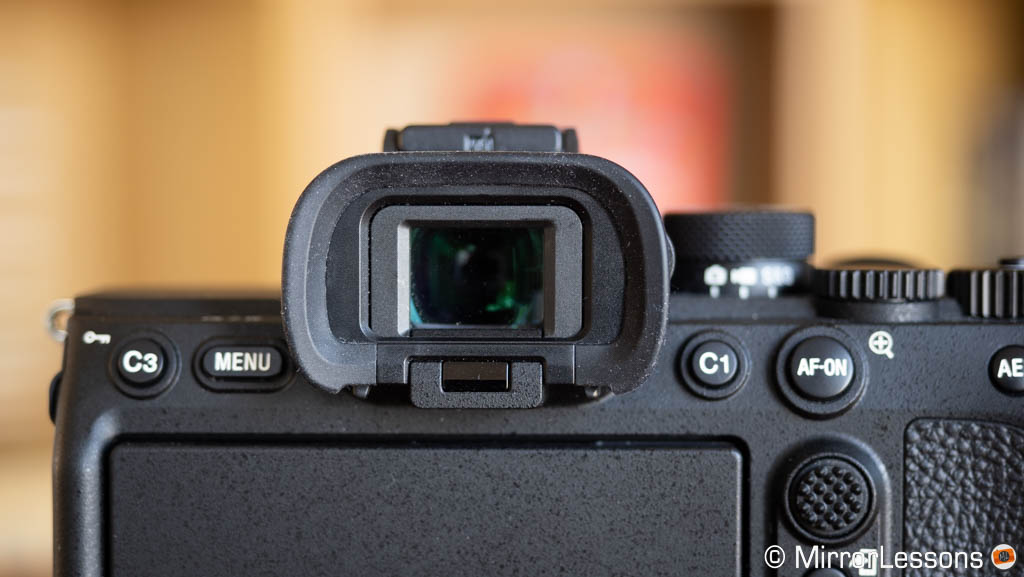
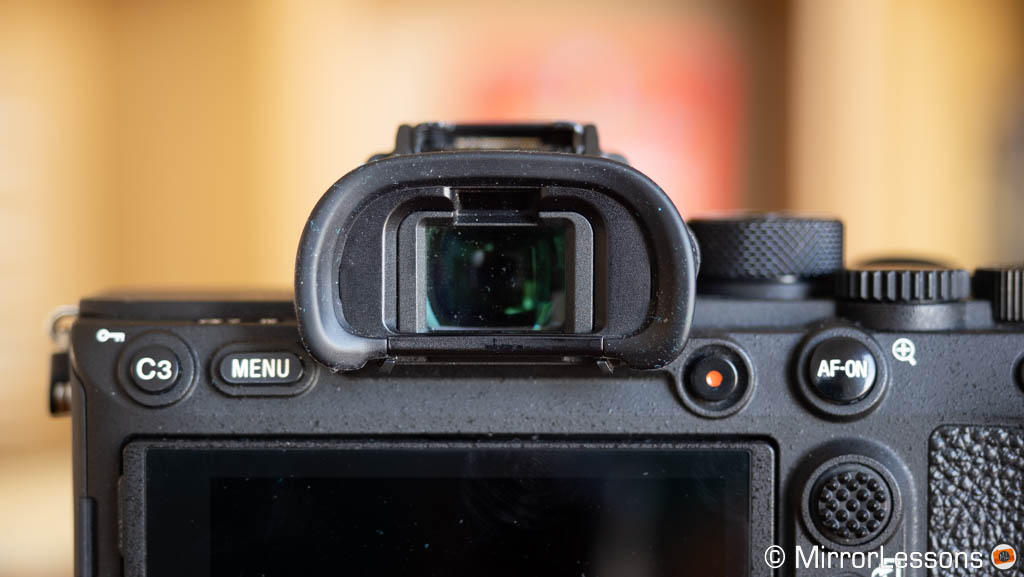
The extra resolution is welcome on the R model, but I admit I didn’t find the difference staggering when using the two cameras on the same day. The rest of the specs are good and, overall, these are two excellent viewfinders.
As for the rear LCD screen, the one on the A7R IV has more resolution (1.44M on the original model, 2.36M dots on the A7R IVA) but it only tilts up and down.
On the A7 IV, the monitor has 1.04M dots. It can be flipped to the side and rotated 180˚.
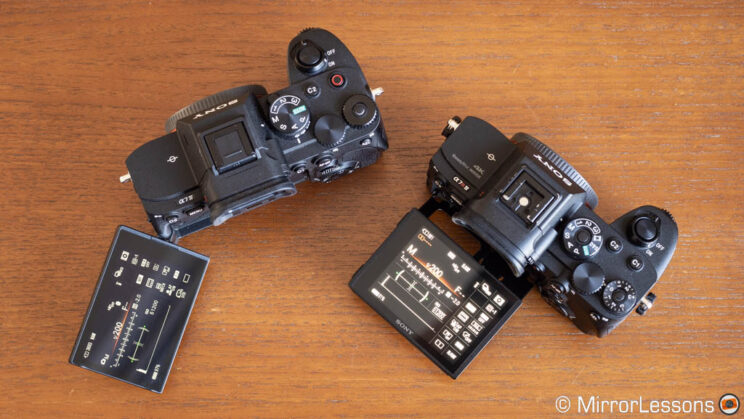
Both LCDs are touch sensitive but there is more you can do on the A7 IV, including navigating the menu and changing settings. On the R model, you can only move the focus point or activate magnification (with a double tap).
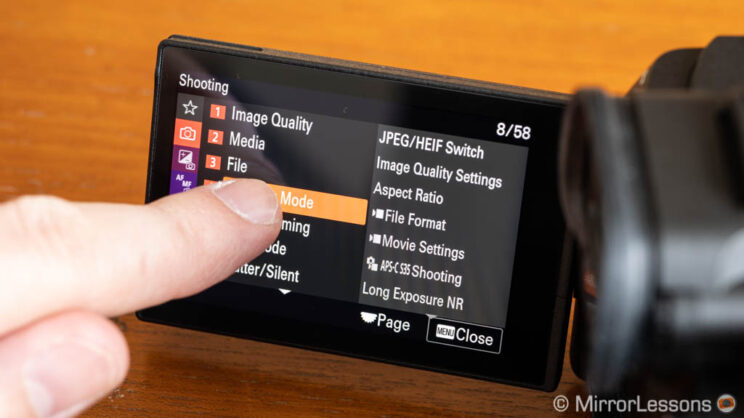
The A7 IV also improves a few things concerning live view in general (EVF and LCD). For example, there is an option to keep the exposure preview optimised for flash work. In video mode, the magnification option is sharper and much more usable.
7. Design and Functionality
The design of these two cameras is nearly identical, and it’s an upgrade that started with the A7R IV, before being copied and pasted onto other recent models. They are both dust and moisture resistant.
- A7 IV: 131.3 x 96.4 x 79.8mm, 658g
- A7R IV: 128.9 x 96.4 x 77.5mm, 665g
Note that on the A7R IVA, the Sony logo beneath the larger, higher-resolution screen is absent.
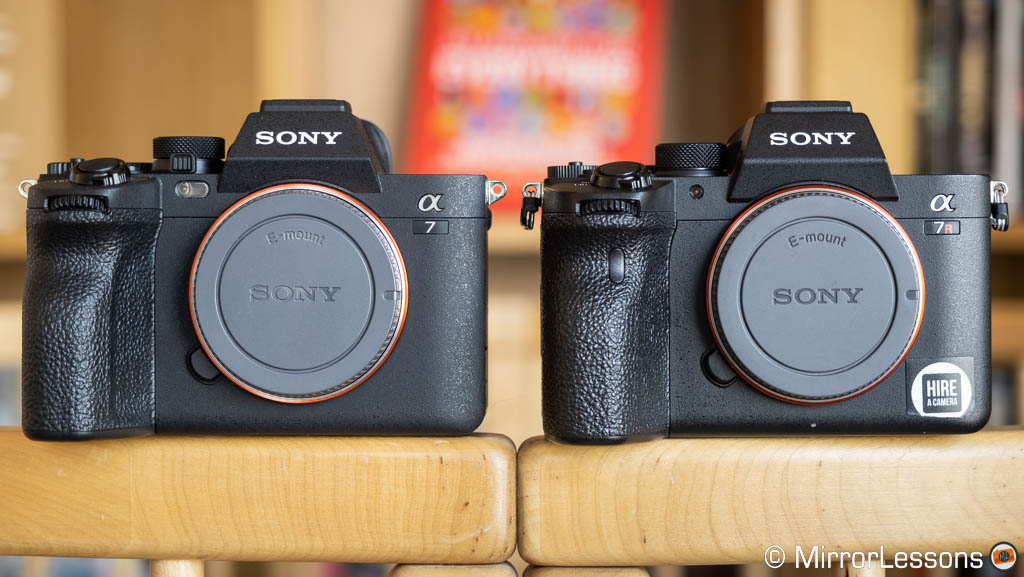
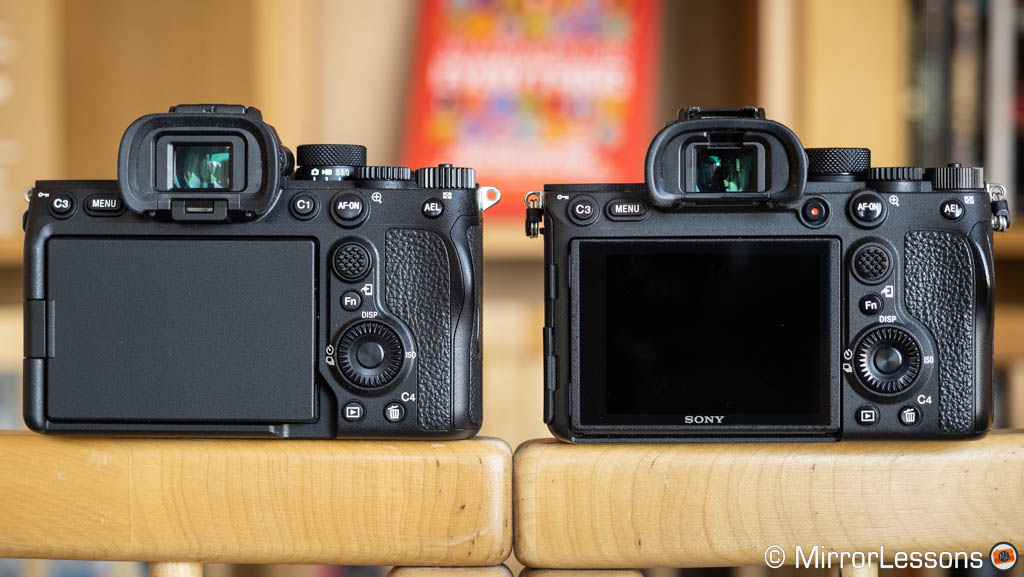
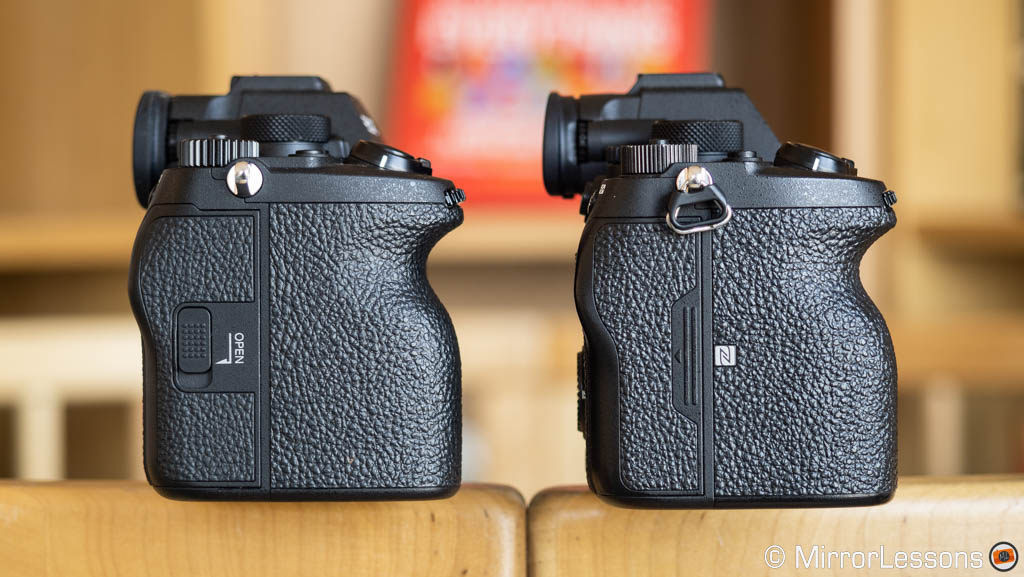
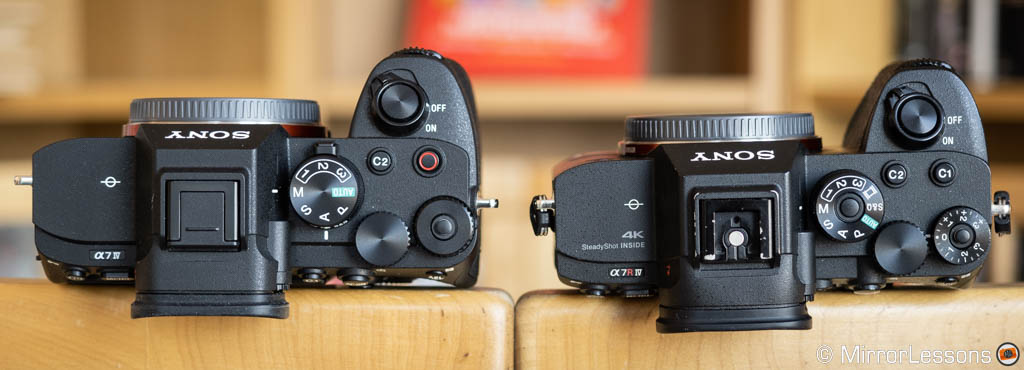
With that said, there are few things worth talking about. First, the A7 IV is slightly bulkier because it has a heat dissipation structure that allows it to record 4K video for long periods of time without overheating.
Another difference is the position of the video recording button, which is found on top on the A7 IV, and on the rear near the viewfinder on the R model. The one on the A7 IV can be customised.
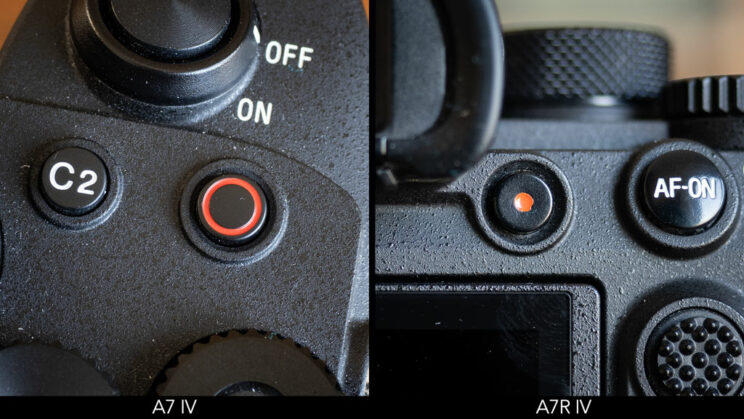
Then we have a sub-dial on the A7 IV, found under the main dial on top, that allows you to switch from stills to movie or S&Q mode. This means you can use the top dial to set the exposure method (Aperture, Shutter Speed priority, Manual or Program) without the need to go inside the menu when working in video mode, unlike with the A7R IV.
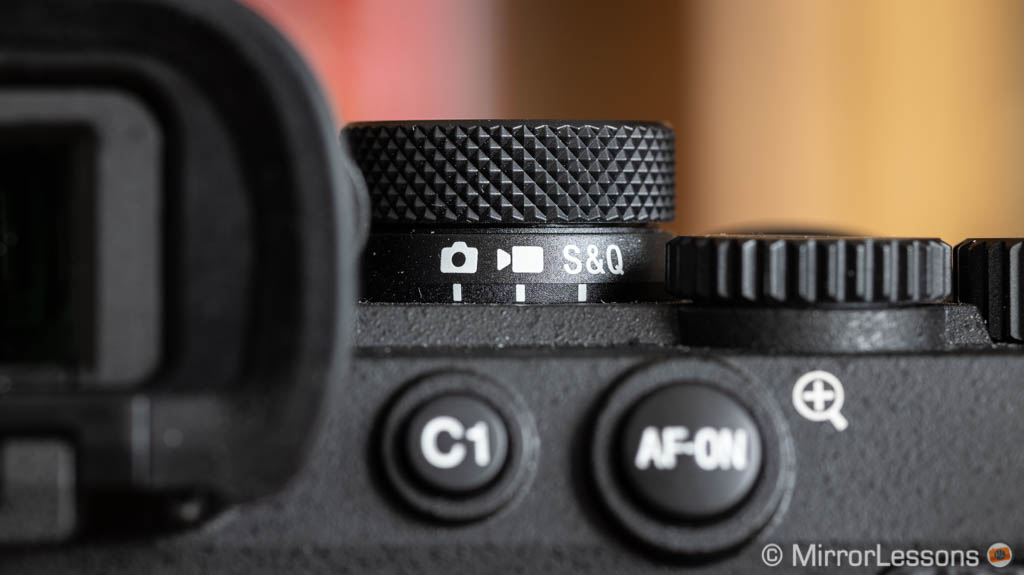
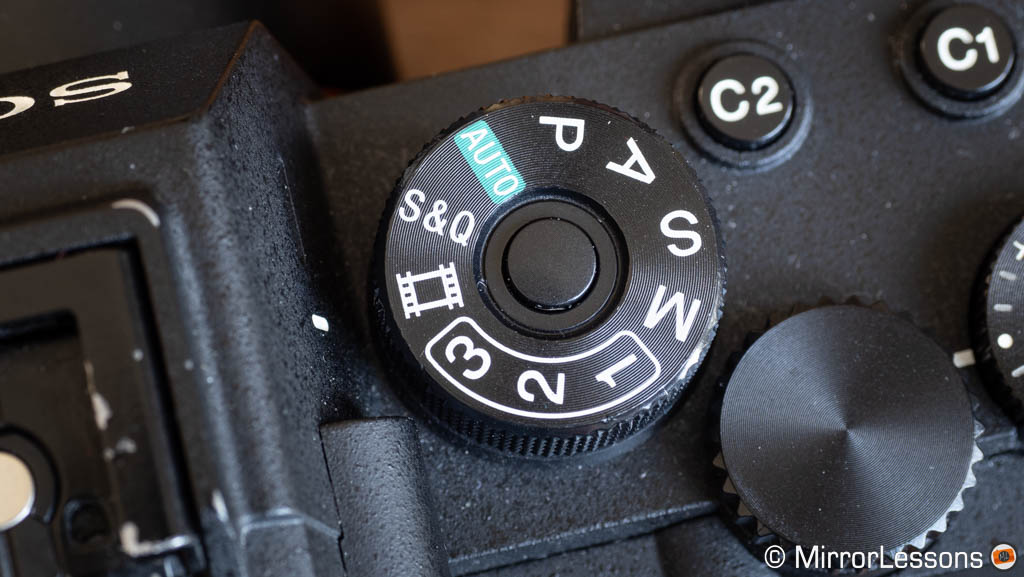
When you switch from photo to video or S&Q, the menu also changes to display the appropriate settings. You can change certain settings such as aperture or ISO independently for video and photo modes. Last but not least, you can use the Memory Recall function for video as well!
Another difference is the exposure compensation dial, which doesn’t have any markings on the A7 IV and can be customised.
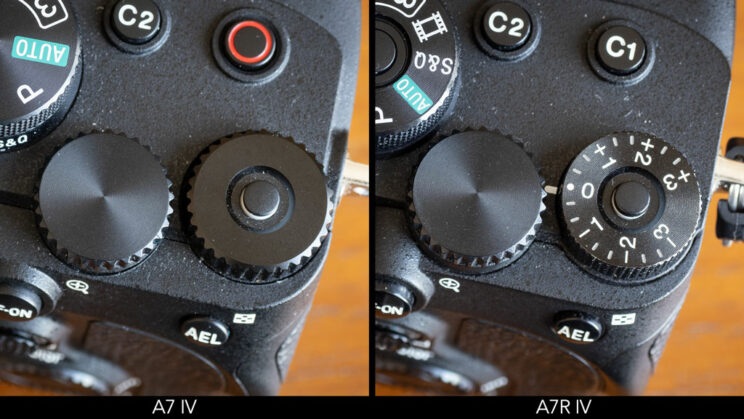
The A7 IV features the latest menu design which is much better organised than the one found on the R model, and is compatible with touch sensitivity. They both have 12 custom buttons and a Function menu (quick menu) that can be configured independently for stills and video.
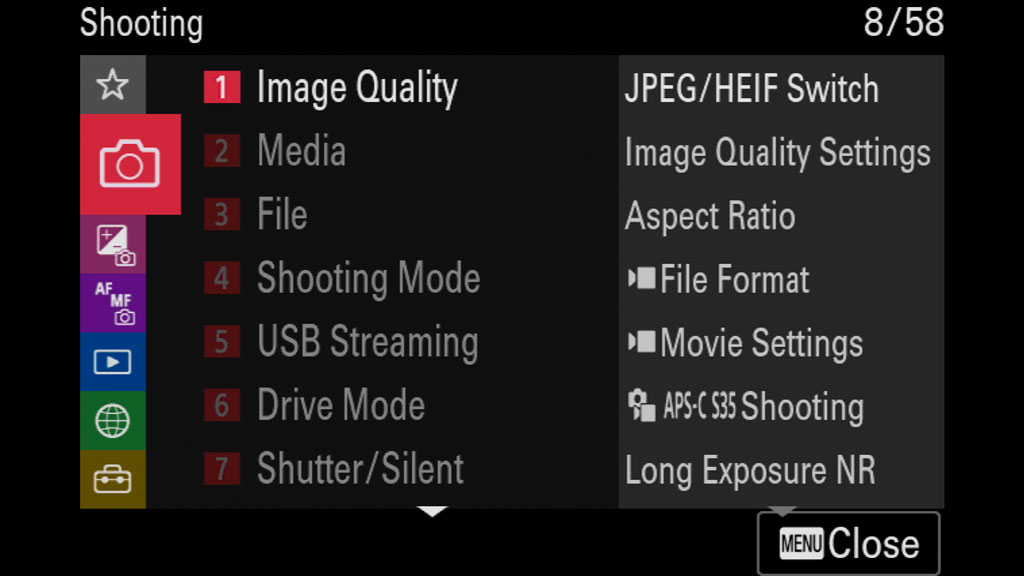

Concerning the connections, the A7 IV has a full sized HDMI (vs Micro Type D for the R model) and can work with a wired LAN connection with an optional LAN to USB C adapter. The A7R IV has a flash sync port.
Speaking of USB C, the A7 IV port works at 10Gbps, whereas the one on the ‘R’ goes up to 5Gbps.
Both cameras have audio in and out (3.5mm socket) and are compatible with digital audio (via the multi-function shoe).
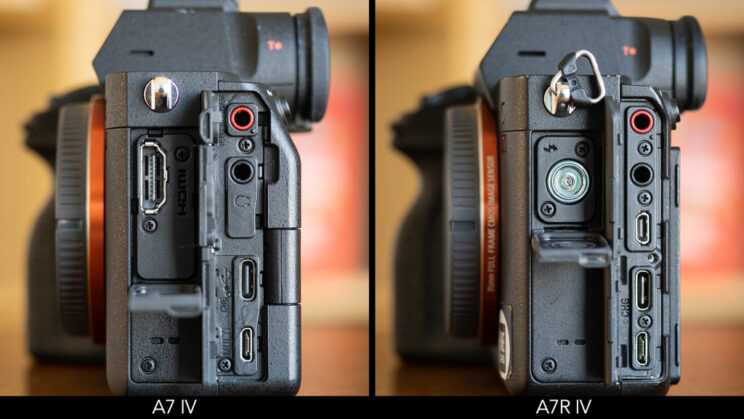
Concerning battery life, they use the same BP-FZ100 battery, but the A7R IV has a slightly higher rating of 670 shots when using the LCD (660 for the A7R IVA), as opposed to 610 for the A7 IV.
In real world use, I found they both deliver a similar performance for stills and video. They can also be charged or powered via USB.
8. Memory Cards
The two Sony cameras have two memory card slots.
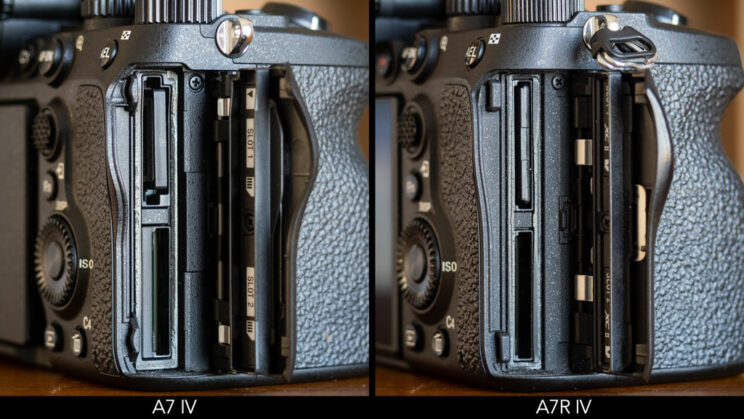
The two slots on the A7R IV accept SD UHS-II cards, just like the A7 IV. However, the latter can also work with a CFexpress card (Type A) on the first slot.
CFexpress has a faster writing/reading speed and allows the camera to have much better buffer capabilities, as explained previously. It is also required when recording 4K 60p at the maximum quality / bitrate with the S&Q mode.
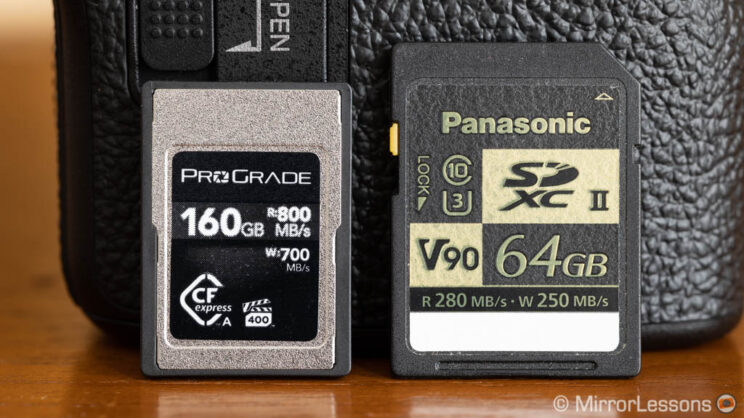
9. Tidbits
Because the A7 IV is a more recent model, it packs additional features you won’t find on the A7R, such as:
- 10-bit HEIF photos: they provide better colour sampling than JPG (8-bit). That said, it’s worth nothing that HEIF isn’t yet a popular format, so not every photo editor software is compatible.
- Soft Skin Effect: available for stills and video, it gives you a decent result with the Low and medium setting, but the higher level can produce an unatural look. For video, I wouldn’t go past ‘Low’.
- Focus Map: it highlights what is outside the depth of field with different colours (red is in front, blue is behind). It looks a bit confusing at first, but can be an interesting alternative to the Peaking function once you get used to it.

- Variable Shutter: it fine-tunes the shutter speed with more precision than the default 1/3 stop, which is useful to eliminate flickering from tricky artificial light sources such as LED. It works for stills and video, and can be quite effective, but make sure to do some tests and check the images, if you can.
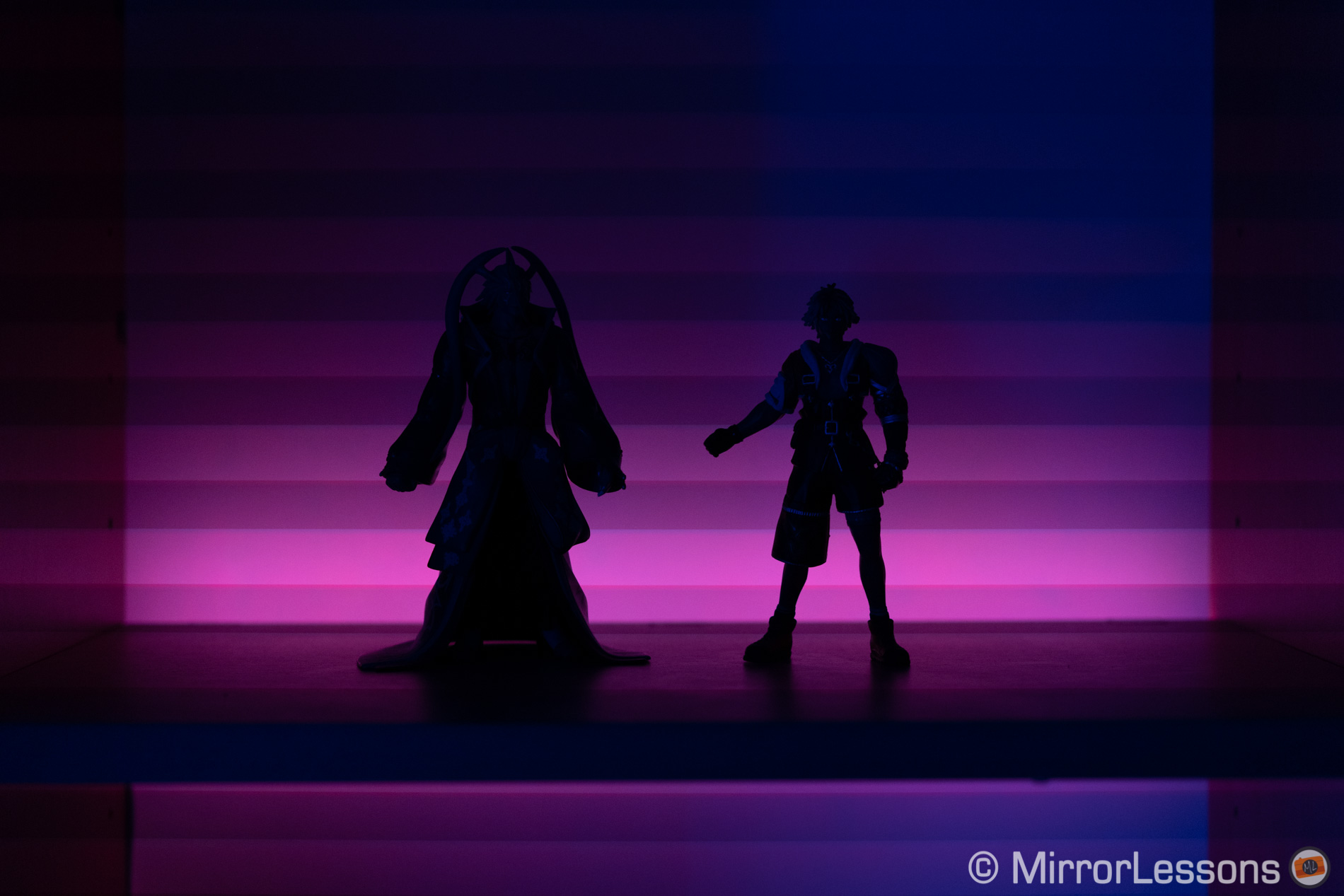
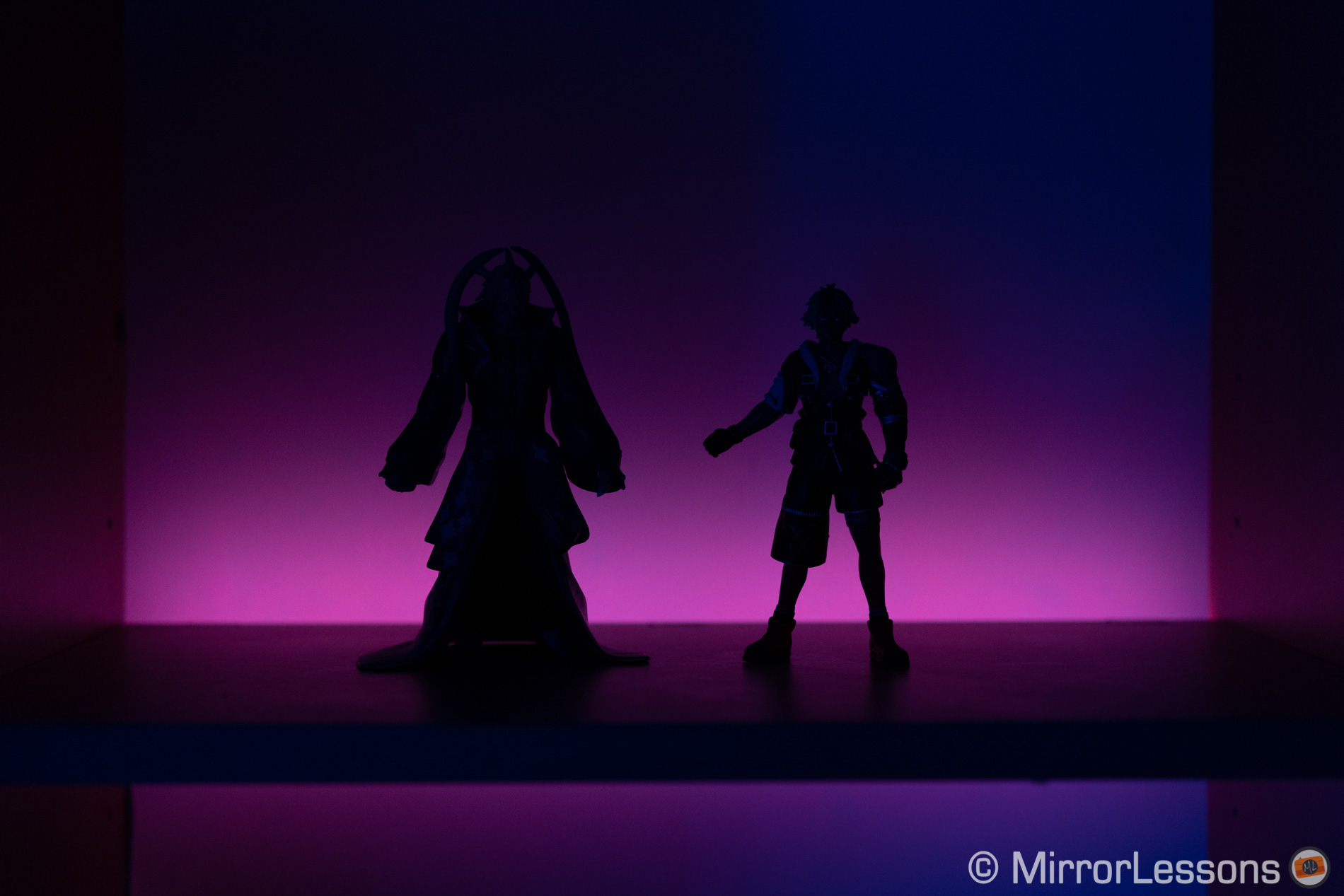
- Anti-dust Function: like the Canon EOS R series, you can have the mechanical shutter curtains closed when turning the camera off to protect the sensor. Keep in mind that these curtains are rather delicate, and can easily be damaged.
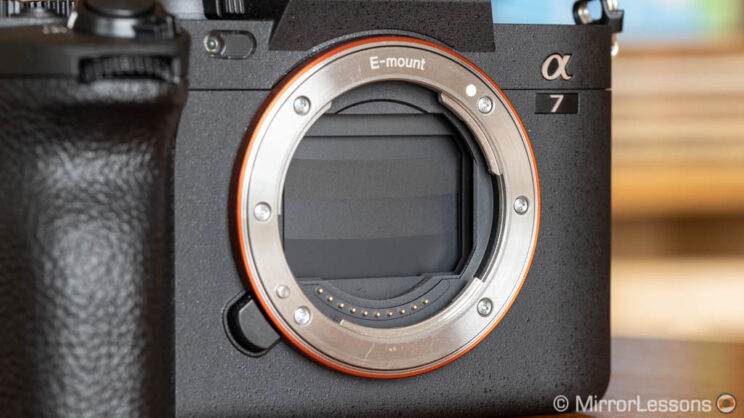
- USB Streaming: the A7 IV works as a webcam without the need for additional software. Just select the option in the menu, connect it to the computer, launch your streaming platform and select the camera as your video (and audio) source. It works up to 4K 15p, or 1080p 60p. You can also use the A7R IV as a webcam, but you need an additional software (Imaging Edge Webcam).
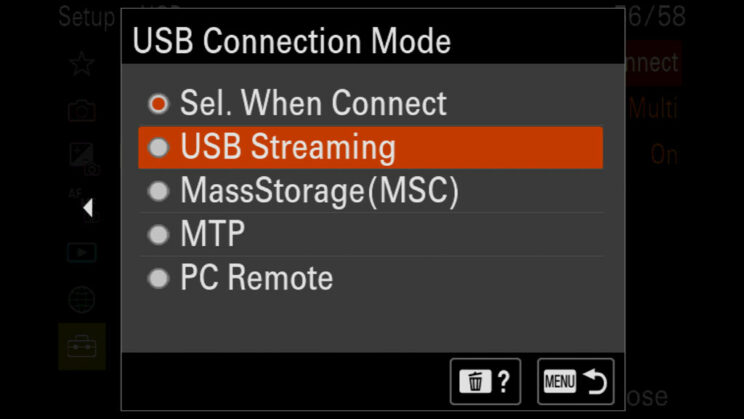
- NFC: no more available on the A7 IV.
- RAW transfer: you can also send RAW files to your mobile device, in addition to JPG files.
- FTP transfer while shooting: you can connect the A7 IV to a server via wifi, wired LAN (with USB C adapter) or a USB tethered smartphone, and send images while working.
- Remote control: the old RMT-DSLR2 remote is not compatible with the A7 IV ( the IR receiver is missing), so you need to use the more recent RMT-P1BT with Bluetooth, or look for a third party option (must be Bluetooth)
And finally, here is a list of things the A7 IV and A7R IV share in common:
- Intervalometer (for timelapse)
- AE, WB and DRO Bracketing
- Metering with five different options (multi, centre weight, Spot Std, Spot Large, Entire Screen Average and Highlight).
- 5Ghz Wi-Fi
10. Price
The A7 IV is available at the retail price of $2500, £2400 or €2800.
The A7R IVA can be found for $3500, £3200 or 3800€.
Note: prices are for the body only and as of June 2022. Temporary rebates or cash-backs might be available for a limited time. The original A7R IV (without the “A”) can be found second-hand around $2500.
Video Review
This article is also available in video format on our YouTube channel. Don’t forget to like and subscribe! Thank you!
Conclusion
There is an easy way to write this conclusion: the A7 IV costs less and, from one perspective, has more to offer including 4K 60p, 10-bit video, better autofocus, more customisation and a good range of extra features. Add to this the fact that the sensor is excellent and that 33MP is enough for 95% of us, and there is little left to argue in favour of the more recent and affordable model presented here.
If we dig deeper however, we find that there is a lot to like about the A7R IV. Unsurprisingly, its 61MP sensor is capable of delivering fantastic images in terms of details, and such a high megapixel count is also handy for sports or wildlife photographers. I found myself cropping my images heavily and still having 20/25MP left over when exporting the photos. The results at high ISO (the levels that count, such as 6400 or 12800) are pretty good too.
The autofocus may be inferior in certain areas (Eye AF for humans, at least when they’re moving) but the performance for birds in flight is much closer, making the ‘R’ a very capable product for wildlife. Last but not least, the drive speed is more than decent for a camera with 61MP.
Ultimately, your budget is likely to play a major role in your decision, but otherwise, it is important to look closely at what kind of performance you’re looking for, and what kind of genre you intend to do with these cameras. They both excel in their own way.
Check price of the Sony A7 IV on
Amazon | Amazon UK | B&H Photo | eBay
Check price of the Sony A7R IV on
Amazon | Amazon UK | B&H Photo | eBay
Second-hand Sony gear on
MPB US | MPB UK
More Sony A7 IV and A7R IV comparisons:
A7 III vs A7 IV
A7R III vs A7R IV
A7 IV vs A7R III

